Talk Sea Fishing provides a comprehensive mullet fishing guide covering the best tactics for all three common mullet species including thick lipped, thin lipped and golden grey mullet.
Thick-lipped mullet are often referred to just as “grey” mullet, and sometimes as the UK’s bonefish due to their superb fighting ability, which is well deserved. A common myth is that mullet are uncatchable. Certainly, they can be very difficult to tempt at times, frustrating even, but sometimes stupidly easy, too. And in reality, that’s the fascination of them!
There are about 80 types of mullet in the world, most falling into the families Liza and Mugilidae. UK thick-lipped mullet belong to the Mugilidae genera.
Thick-lipped mullet are found right across Europe from the North African coast, throughout the Mediterranean, right up the coasts of Spain, Portugal, France, throughout the eastern side of the North Sea as far as the southern coast of Norway. Their territory also extends as far as the south-eastern tip of Iceland, though they can be classed as very rare there.
They inhabit the whole of the UK coastline and can be seen sometimes as far north as the Shetland Islands, though north of a line drawn through central Scotland they become uncommon. In Ireland, mullet are found again along the whole coastline but are commonest south of a line drawn roughly between Donegal and Dundalk, with the southern and western counties seeing the best numbers of fish.
Mullet could be classed as migratory, for although they sometimes over winter in the smaller southern, southwest of England and southern Irish estuaries, also in harbours and marinas if the weather remains mild, they normally leave the coast and head south into deeper water for the winter months.
Male mullet are thought to mature at about 9-years of age and a length of about 42cms. Females achieve adulthood at 47cms and probably 11-years of age. These mullet are thought to only see a proportion of the overall stock breed each year, and probably only in alternate years. This makes them very vulnerable to overfishing.
They spawn in inshore waters in winter and early spring with the eggs and fry pelagic and distributed evenly along the coast by prevailing tidal currents. Fin perfect first-year fish can often be found in small saltmarsh pools and shallow estuary creeks along with bass, also in shoreline rock pools after a high tide when they get stranded. Thick-lipped mullet are thought to be able to reach 25-years of age in exceptional circumstances.
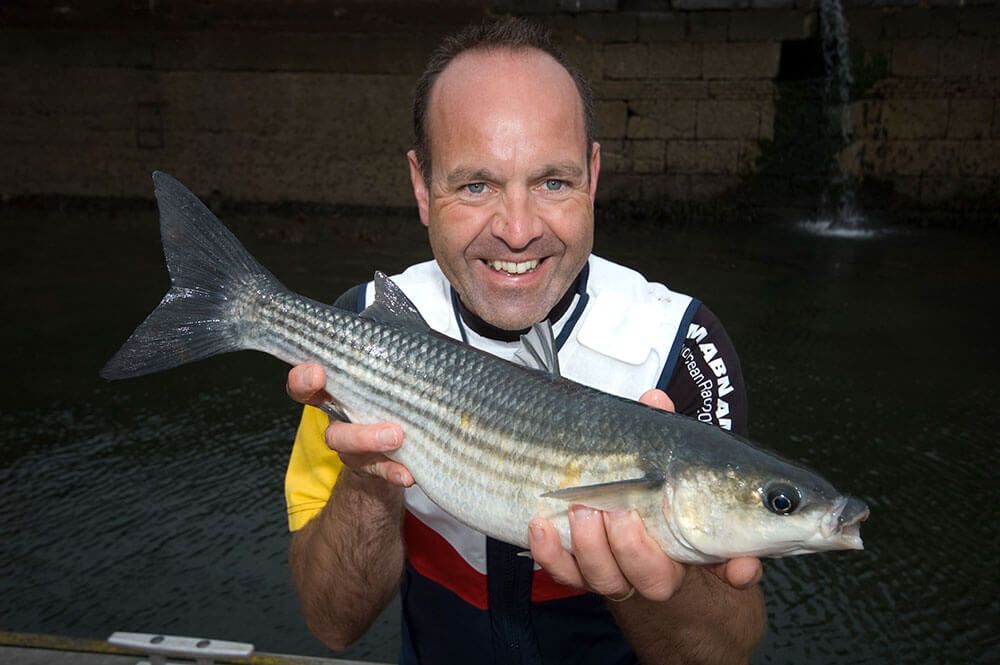
In the warmer Mediterranean mullet can achieve weights to approximately 18lbs, but this is very rare. Few fish achieve double figures in reality and a 10lb fish is exceptional in UK and Irish waters. Most mullet weigh in the region of 2lbs to 4lbs in weight, with a 5lb fish being classed as a specimen in most areas.
Grey mullet have a typical round fish body shape, the flanks are covered in large, heavy protective scales. It has a four-spined dorsal fin, and the upper lip will be more than half the eye diameter, with the lower part of the lip covered in small densely packed teeth and carrying small taste bumps called papillae.
There are two other types of common mullet, the thin-lipped mullet and the golden grey mullet. Their habitats can coincide, and anglers can find it difficult to identify the individual types, but there is an easy way.
On the thick-lip, pull the pectoral fin backwards towards the eye and the tip of the fin will reach as far as the forward edge of the eye pupil. On the golden grey, the tip of the fin will reach to the rear edge of the eye pupil, and on the thin-lip mullet, the fin brought forwards will see the edge fall fully behind the eye socket. The thin-lip also has a black spot at the base of the pectoral fin.
The majority of grey mullet are slate grey on the back shading to white on the lower flank and belly. Sometimes the fish takes on a green/blue hue and sport darker backs when living in harbours and working alongside weed-covered man-made structure. They sometimes have a hint of yellow or gold around the head too. The ventral fins can be white, with the anal fin a slight grey colour.
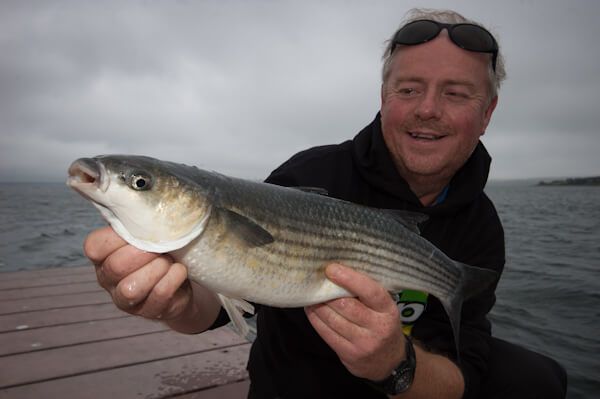
Thick Lipped Mullet

Golden Grey Mullet
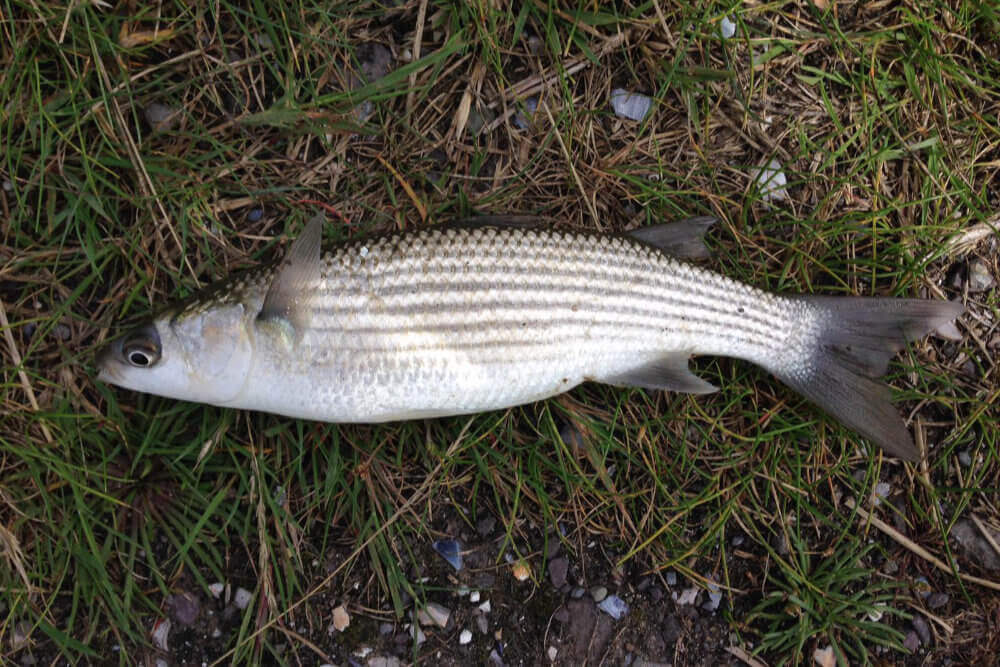
Thin Lipped Mullet
They normally feed on plant matter, algae, nematode worms, copepods, small fish and larger worms.
Mullet will scrape their mouths along the sides of muddy creeks leaving a distinctive and visually obvious scar which is useful in finding their preferred feeding areas. In doing this, they filter out the food in the mud, then displace the unwanted mud out through the gills, it’s a form of filtering.
Mullet are an intelligent fish, well capable of working out simple problems. They are quick to take advantage of unusual but area common food items that enter their realm. Things such as waste fish scraps from commercial and charter fishing boats washing their decks off after a day’s fishing, human food waste is thrown into harbours and marinas including chips, bread, pasta and meat. They are also partial to the maggots found in rotting seaweed in high summer along the tide line of sandy and shingle beaches.
They also have a great sense of timing and will turn up close to pipes that pump natural fish waste into the sea just before the pipe switches on.
The traditional mullet season starts in April in the south of England and maybe late April in average weather years along the Welsh Coast and in southeast England. It’s often late May or even early June before they show in the more northern areas. They stay until October and even November in the south if the frosts are not severe. Their numbers peak generally, from June to September with August and September often the best months of all.
They tend to be an estuary dwelling fish not averse to travelling as far as the divide line between salt and freshwater. In estuaries they will work through the main estuary channel with the tide, then enter drainage creeks and access salt lagoons as these flood deeper with the incoming tide. Over high water, they linger in the deeper channels, but also wander freely over flooded saltmarsh if the depth of water allows.
Mullet will also frequent the open coast being seen off beaches swimming in the inner surf tables like bass, but over high water will feed along the high tide line taking maggots from rotting seaweed and sea slaters in summer. They can also be found off open rock marks feeding inside small bays and in amongst weed beds.
Thick-lipped mullet are a shoal fish but are usually in smaller groups or individual fish when accessing creeks and smaller bays. They can often be seen with their mouths dimpling the surface or head and fin making a V wake as they power forward. This is distinctive and again a giveaway as to where they patrol and feed.
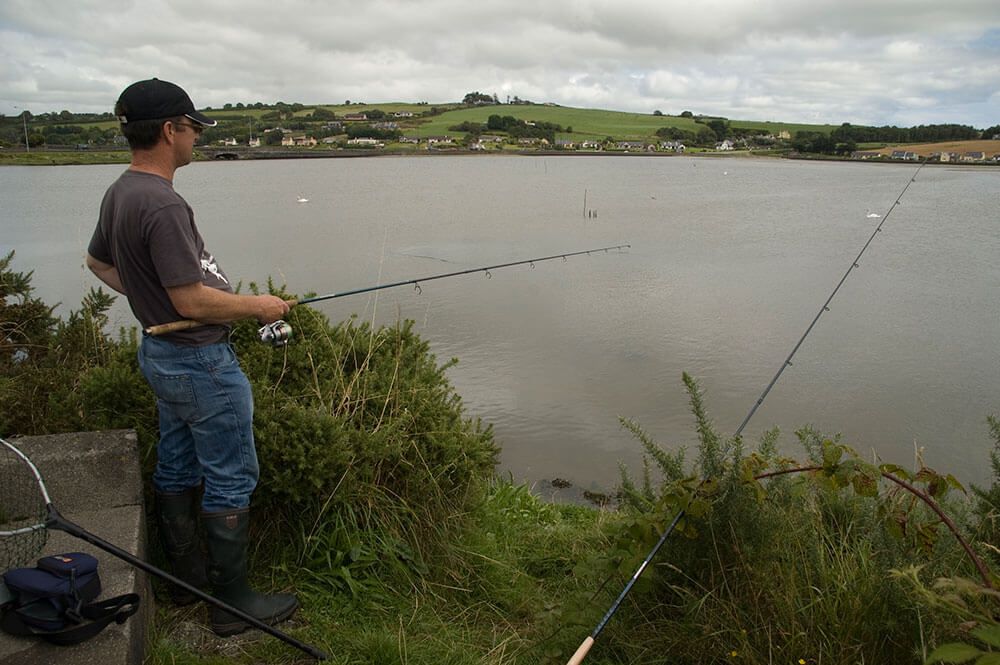
Small working harbours and marinas are one of the best places to see mullet cruising and feeding. They show on the surface with their typical V wake indicating their swimming direction. They are quick learners and will stay outside the harbour confines until the boats head in, in the evenings then suddenly appear and begin to feed on the scraps and fish bits that enter the water as the boats unload and clean down. If you’re allowed to fish right in amongst the boats and their mooring ropes tight alongside the boats when the activity dies down a little, you can enjoy some great sport.
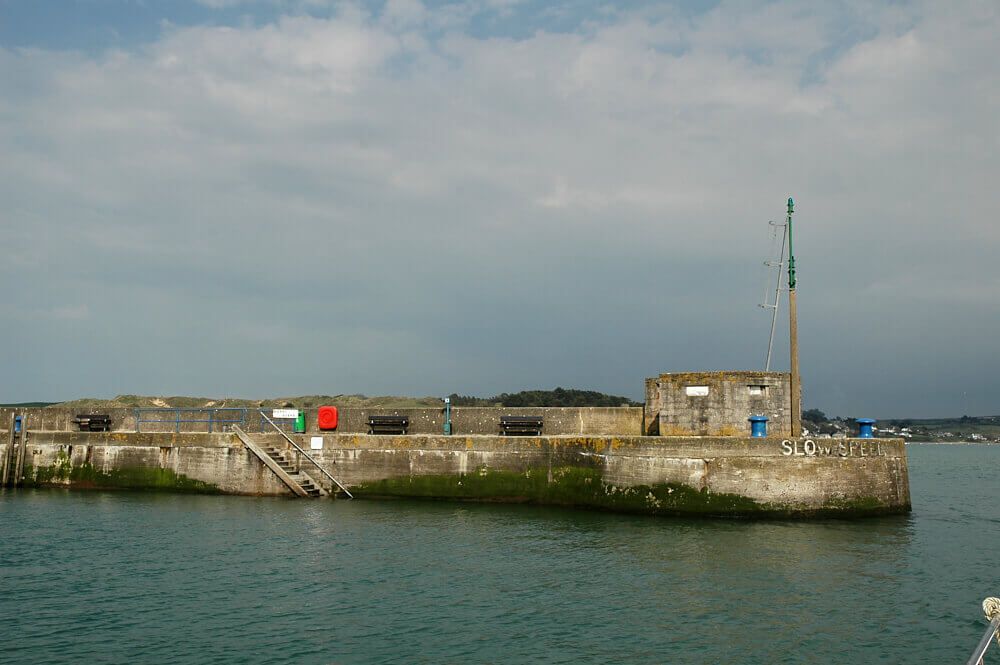
In shallower harbours that all but dry out at low water, the mullet will filter in with the tide as soon as there is enough depth for them to swim in, but equally will move out fast as the tide ebbs.
Also try alongside the harbour walls, especially if there are tourists about and parents and children using crab lines. The food that gets thrown in or blown into the water, plus the bait used for crab lines becomes a natural ground bait that will hold the mullet’s attention.
Another good spot is where shallow mud flanks up to seaweed along the shore next to harbours. If you’re quiet and keep your shadow and silhouette off the water, you will often see the mullet cruising these edges in just inches of water, their backs fully above the surface.
In marinas, again not all allow fishing, the mullet will be ever-present due to the greater depth. Their typical haunt is in the shadow of either the boats or working right under the pontoons nosing in amongst the weed growth on the supports. You need to walk lightly so as not to disturb the fish under the pontoons and baits need to be placed to look as if they have fallen in naturally.
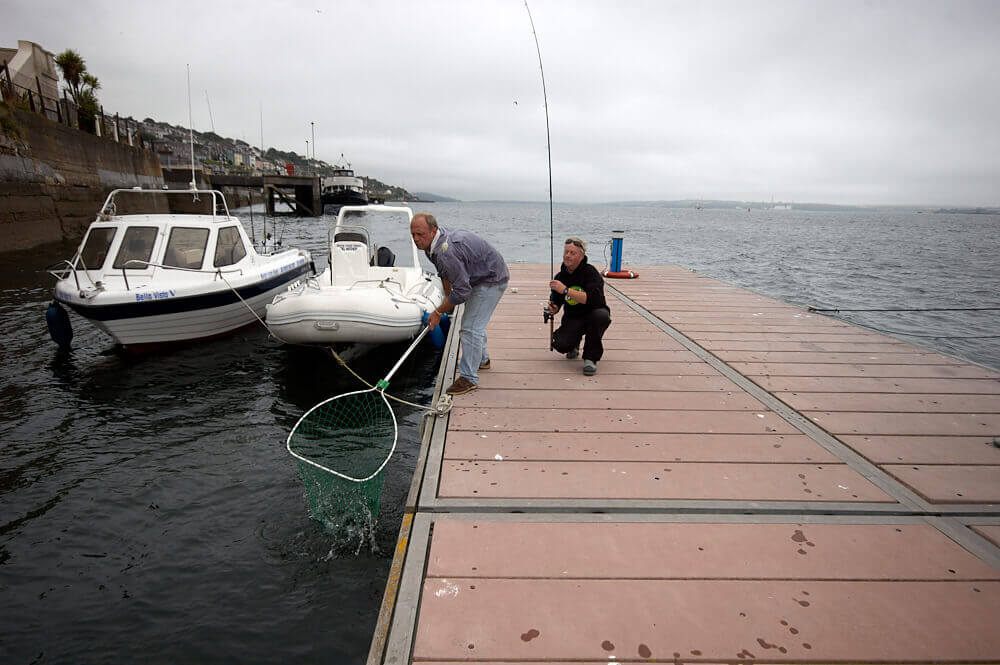
Thick-lips also frequent breakwaters, piers and jetties. They will be seen free swimming along the edges of such man-made structures, and often have a particular route they patrol when feeding. Some of the best areas, if you are allowed to fish them, are where the structure has a bend in it, or where the weed grows along the low water line. They will also feed on the growth that is found on jetty and pier pilings right underneath the structure.
Some breakwaters have outlet pipes that filter off waste from commercial fishing process plants. If you can find such a place, then it's likely the mullet will be there in great numbers and you’ll see them on the surface and also watch them swimming right up to and even into the pipe itself.
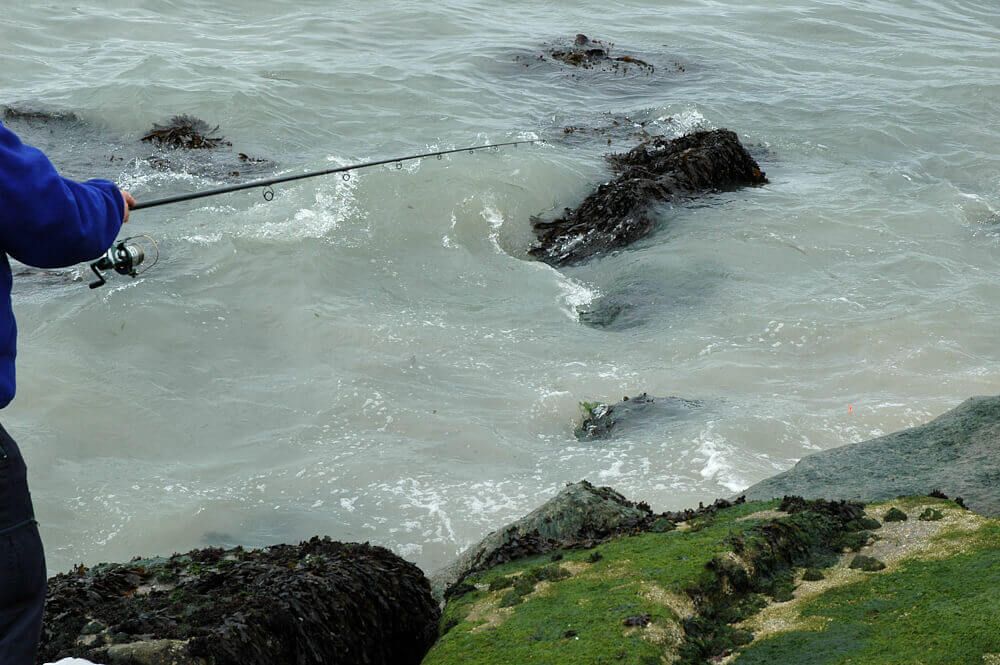
Mullet use the flooding tide to access all areas of an estuary environment. They will follow the shallow side creeks that drain the flood tide off, lingering in small indentations in the bankside, also working through weed growth. They also access the upper salt marsh creeks and weed beds and love the deeper pools where maybe a sluice gate draining off land water enters the creek and forms a deeper pool. They will swim right into the junction line where saltwater meets freshwater, so no area is out of bounds to the inquisitive mullet.
Other good estuary spots are where small muddy bays form, often with weed along the low water line. Mullet work the bays fully and again can be seen cruising. Also places where small streams wash into the estuary or areas where drainage water seeps back seaward.
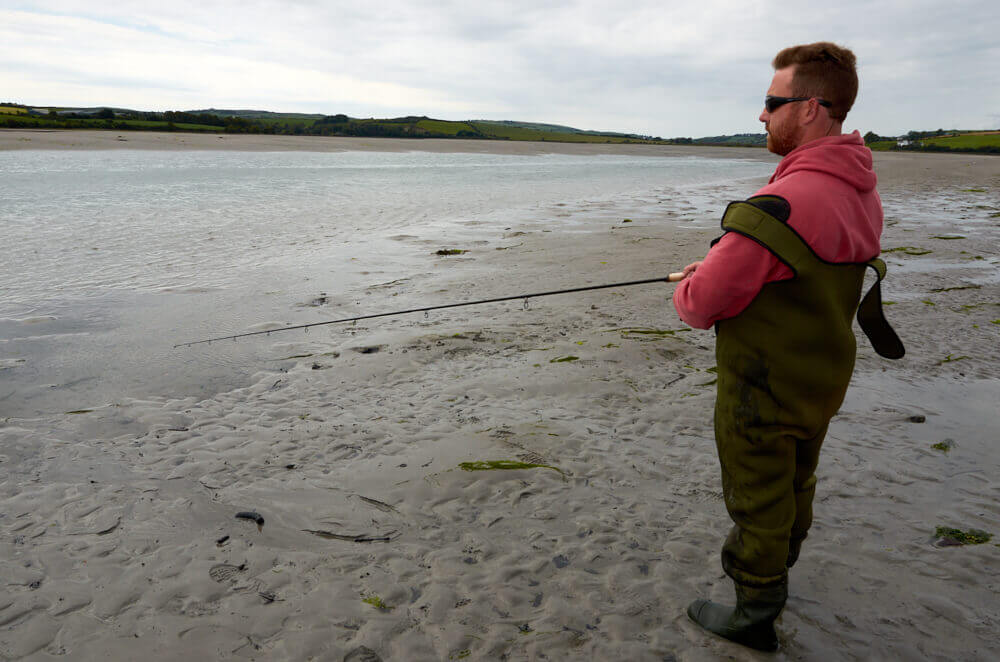
From mid-summer, mullet will also be found working the ends of beaches and inside small seaward facing bays. The best time to fish these is when there has been an onshore wind and there is an accumulation of seaweed along the high tide mark. The seaweed rots and becomes filled with wriggling maggots. As the flood tide reaches the tide line, the maggots continually wash into the sea forming the very best groundbait and the mullet will move in, in numbers and can, at times, be suicidal in taking maggots. This is typically in the late July through to early October period and works best in calm seas with light surf.
Grey mullet can also be found off open rock marks facing into the open sea. This is especially common in the Channel Islands, off the Devon and Cornish coast, off Wales and along the Irish south and southwest coast.
Tides are not so important in many cases regarding mullet compared to other fish. Estuary and harbour mullet will feed most tides, both big and small. They also work up the estuaries and into the side creeks but obviously on the smaller tides the ground they can access is more limited.
Estuarial mullet will stay in the deeper brackish pools at the heads of estuaries until the next tide returns, but fish feeding in the salt marsh creeks will move in with the flooding tide, linger over high water, but by the first hour of the ebbing tide will be dropping back quickly to the main estuary channel.
Depth is the motivator for moving regards harbour and breakwater mullet. They feed best during the flood tide but again will move out and often disappear as the ebb tide starts to run, though this can be depth driven. In deeper water, they will linger longer or not move far at all.
Mullet are caught in daylight, also at dusk and dawn, but almost never in full dark when they seem to go semi-comatose and refuse to obviously feed. They can be the odd exception when bright streetlights are right by the waterside. Sometimes, mullet will feed in this artificial light if there is an obvious and consistent food source available to them. This is rare though.
They will take in bright sunlight, but generally, the better conditions are an overcast sky and a light breeze enough to ripple the surface water to cut down on light levels which seems to make the mullet feel more secure and willing to feed.
Mullet like relatively calm weather when working in shallower water. In deeper water, say inside marinas and harbours, then although you maybe can’t see them, they will often be feeding on the bottom in rougher weather, again this will be reliant on a natural or artificial food supply being available.
In very rough weather, stick only to deeper harbours and marinas, or high up the estuary towards the freshwater line. That said, mullet do not like heavily coloured acidic water caused by heavy rain over the mountains or moors.
Ledger and feeder fishing
Targeting mullet when close to tied up boats, mooring buoys, ropes and other harbour obstructions, also when fishing marina pontoons and breakwaters, the fighting abilities of mullet need to be taken into consideration with strong tackle required to keep the fish away from the snags, if possible.
For this type of fishing the modern freshwater feeder rods, such as the 11ft Cadence CR10 Feeder number 2 or number 3 are a good choice being a medium and stronger action respectively. They are supplied with three tips covering casting weights 1oz, 1.5oz and 2oz, so cover most mullet situations. These have a soft tip and upper mid-section, which helps to cushion the lunges of the fish, but there is real power in the lower mid-section and butt that aids casting but also adds the necessary power in the rod to turn and tire big powerful fish. This is the best choice when feeder fishing or light ledger fishing, and also for casting bubble floats with bread baits.
Fixed spool reels in sizes 3500 or 4000 are ideal loaded with 12 to 15lb braid. The braid, having no stretch, helps you apply heavy direct pressure to the fish and helps you turn it away from any obstacles. It also, in theory, lessens the time it takes to tighten into the fish, which can be an advantage when after mullet. That said, mullet can be very line shy, so when using braid, always fish a short 5 or 6ft section of 6 to 8lb fluorocarbon. Alternatively, load with a full fluorocarbon mainline in 6 to 8lbs and fish it straight through.
Feeder fishing with either open-ended cage feeders, or better still the Guru mould type feeders, works very well. You can load these with a bread mix, or liquidised bread and light groundbait mix, possibly with a few maggots added or flakes of mackerel. Keep the hook length short, no more than 6-inches and make it from fluorocarbon so there is a little stiffness there. Hook size should be a size 8, say a Drennan Super Specialist for strength. Bait with a small flake of bread, or a couple of maggots if they are in the groundbait.
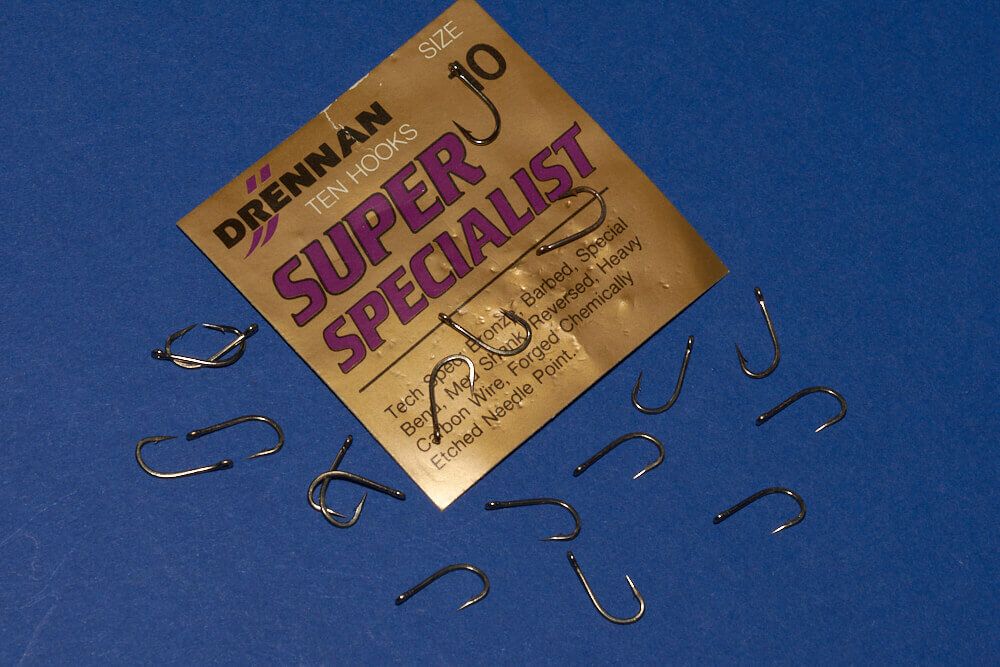
Make sure you cast to the same place each time by putting the line in the line clip. This helps keep a little bait trickling out in the same area and will help to keep the mullet interested. Bites will be a single solid pull round of the rod tip. These fish often self-hook, but to make sure, lift the rod up and just tighten into the fish. Do not strike as this can either pull a light hook hold free or snap a light hook link.
To ledger fish, a good set up is to just use a sliding ledger, the weight free to slide on the mainline, stopped by a rubber bead and a tied-on swivel, then use 12 to 18-inches of 6lb fluorocarbon and a size 8 hook. This works well if you’re able to groundbait from above and can keep the groundbait and rig in the same vicinity. Bite detection is excellent as the hook and line are direct to the rod tip.
Bubble float fishing
This is one of the most successful ways to fish for mullet using bread. Choose, if possible, the oval-shaped bubble floats sliding this up the fluorocarbon leader or mainline and lock it in place. Add a little water for casting weight, if needed. The hook length needs to be 6lb fluorocarbon and anything between 3 and 5-feet. Go shorter for longer range and longer for casting close. The hook is tied direct to the fluorocarbon and should be a size 8 Drennan Super Specialist.
Scatter no more than half a dozen 50p sized free offering bits of bread onto the surface in the vicinity of the cruising mullet. Try to be patient and let them get confident in feeding on the bread. Keep adding two or three bits of bread to keep it going. Once the fish are feeding constantly, pinch on a 50p size piece of bread, crimp it around the hook length directly above the hook, then hide the hook point by enclosing the hook in the bread and crimping the edges with your fingers. This hiding of the hook secures the bait better but can make a big difference when the fish are in totally clear water and visually capable of spotting the hook and realising something isn’t right, which they do often. The hook pulls easily through the bread when you strike, anyway.
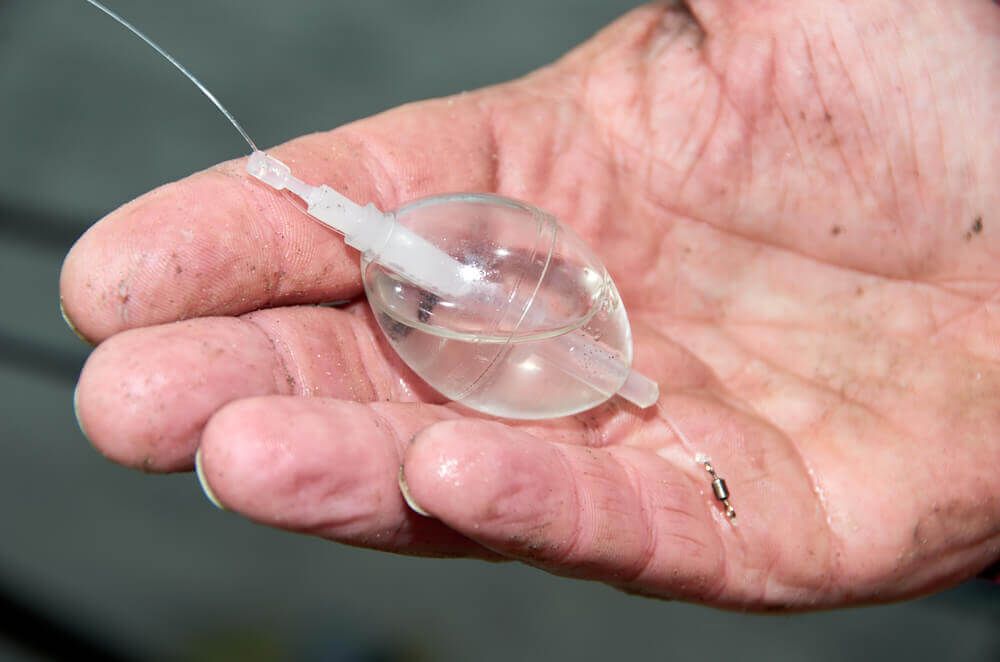
Try to anticipate where the fish are going to be. Don’t cast straight at them as this will just put them down and spook them. Study the patrol route of the fish and place the bait where they are likely to swim too, or, cast well over them and then draw the bait in slowly a foot at a time.
For bite detection, you have the choice of watching the bread bait on the surface, waiting for the swirl as the mullet sucks it in, count to two, then lift into the fish. Alternatively, watch the bubble float and when it slides across the surface, strike. Once you have the knack, watching the bread is the best way.
Our Sea Fishing Rigs section has a step by step guide to making a Mullet Bubble Float Rig.
Float fishing
For float fishing, look to a freshwater float rod, something like the Cadence 12 or 13ft options. Again, they have a forgiving action but offer real power low down to fight heavier fish with. A good reel for this rod would be a size 3000 fixed spool reel and load with 4 to 5lb mono in a clear or clear brown colour, both these lines seem to camouflage better in the water.
The best floats are the loaded Crystal Wagglers used in coarse fishing. They are long and well balanced and will, in the appropriate sizes, cast a long way and sit well even in windy driven surface water. They can be rigged by positioning float stops either side of the float on the mainline, so you have instant depth adjustment. These need to grip though, so if in doubt add two float stops back to back at either side. In shallow water, add a couple of very small shot to get the float to sit just proud of the surface, but also to gently let the bait sink down naturally. The natural drop of the bait can be key when float fishing, so keep this in mind. In fact, if you know mullet are present and you’re not getting takes, try adding or removing shot to within 15-inches of the hook until you find the drop speed they want.
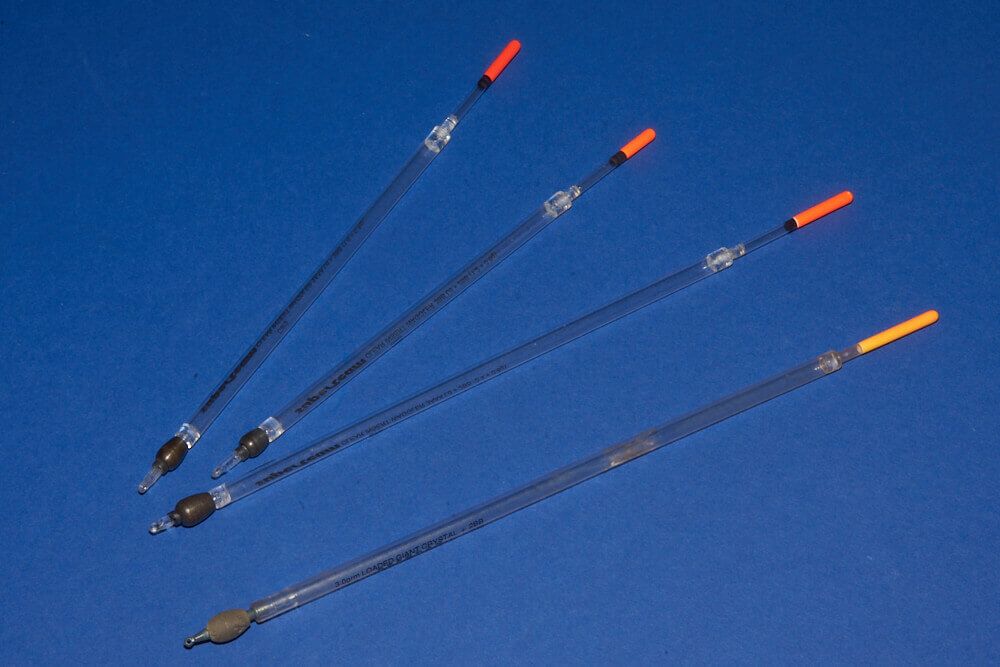
Mullet can be depth specific when it comes to taking baits, so adjust the depth of the float up and down by 6-inches until you start to get takes.
Also, as when bubble float fishing, try to cast over the fish and then gently draw the float in towards them to avoid spooking them.
Drop down mackerel technique
This is a very effective and quick method to get mullet feeding alongside a harbour wall or when fishing piers and jetties.
Rig up as before with a feeder rod, 3500 to 4000 sized fixed spool reel, 15lb braid and a short 10lb fluorocarbon leader. To the end of the leader tie on a size 6 rolling swivel. The hook length is 12-inches of 6lb fluorocarbon and tie on a size 8 Drennan Super Specialist hook or similar pattern. To the larger size 6 swivel tie on a short 6-inch section of 20lb mono and a size 2/0 hook.
Take a whole ideally fresh mackerel and cut it into three equal sections. Push the 2/0 hook well into one of the sections, the head and middle body sections are best for this. This is not to catch fish but purely to hold the mackerel section in place. Bait the size 8 hook with a small sliver of mackerel just enough to hide the hook.
Drop the mackerel section and bait hook over the side of the harbour wall but keep it as close to the wall as you can. Give it a little shake now and then to release little bits of fish that will fall off and drop down through the water column. Mullet will find and follow this trail of smell and food bits and eventually see the baited hook which looks just like a small bit of fish falling off the main section and take the bait without fear. This method works especially well where commercial boats and charter boats dock in the evenings, but it will work at all other times too.
Rock fishing
Open coast rock fishing can be hit and miss but tends to produce a better than average size of fish. By open coast it means rock ledges that give in to fairly deep water. It surprises many that mullet are living here, but you can often see small shoals of them pass by when fishing for other species.
You need to make a semi liquid chum. This can be any minced-up fish but oily fish like mackerel or tins of tuna, pilchards and sardines work best. Smash these up then add liquidised bread or bran. The bran is good as it soaks up the blood and juice and will filter down through all levels of the water column. It matters not if this brew is left to go “high” for a couple of days.
Choose a spot on the rocks where you have access to land fish easily. Also, one where you can fish well back from the water, so you are not easily seen. Float fishing with small mackerel baits is the best tactic, but you might need to use bigger cigar shaped floats rather than normal Waggler floats due to the sea swell. These are simply rigged by sliding a 5mm bead on to the main line, then the float, a ball-weight big enough to cock the float, another 5mm bead then tie on a size 6 rolling swivel. The hook trace is 18-inches of 8lb fluorocarbon with a size 8 hook attached. Keep the float as small as is sensible and add enough weight to have it just proud of the surface. If it occasionally bobs under in the swell, it does not matter.
Use a soup ladle to throw the groundbait mix into the sea. It only needs to be dropped in really as the sea swell will carry the groundbait outwards. At first throw in three of four ladles full, then wait a minute and add another. Do this for 20 to 30 minutes, then start to fish, but keep throwing in some groundbait every few minutes. This will draw any mullet into the area, but also induce bites from wrasse and pollack too, so sport can be lively.
The real key to getting mullet to feed is to apply ground bait. This need be nothing more than liquidised bread, which will work well on its own when fishing harbours and estuaries, but is even better if you had either a tin of tuna or mackerel in sunflower oil, which works really well especially when float-fishing as it hangs in the water column better due to the oil.
If you choose somewhere you want to fish, then find a spot where you can have a small bag hanging in the water uptide of where the fish usually feed, this is perfect. The trail of food particles trickling off downtide will draw the fish in and you trot a bait down on a float to give perfect presentation. In deeper water, form the bread mix into small golf ball sized balls and throw these in so they sink before breaking up. This will need to be a firm mix just stiff enough to hold together.
What does work well is to not fish for a few days but apply the groundbait exactly where you want to fish from every day at the exact same stage of the tide. Note we said, “same stage of tide”, not the same time. This is important and educates the fish to expect food at a certain spot at a certain time of tide and once you begin to fish it can produce some excellent catches.
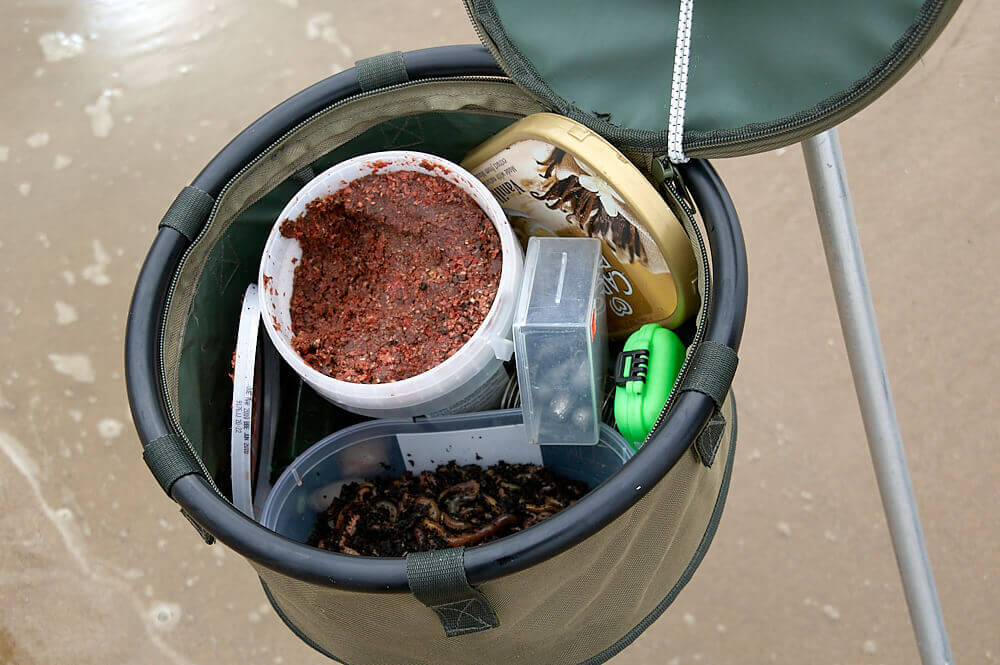
As we’ve seen, bread is one of the best baits as the mullet come in contact with it regularly during their tidal migrations due to people throwing it in for ducks and other wild fowl as well as sandwiches thrown from harbour walls.
Other baits that work well for mullet are maddie or harbour rag, very small bits of mackerel if you’re fishing by boats or have groundbait with mashed up mackerel or tuna in, small chunks of king ragworm, which can be deadly in harbours and when ledger fishing, also, in harbours and marinas, small bits of meat such as tiny bits of ham or pork as these will be thrown into the water naturally by boaters. Squid can work too, as will maggots, and sometimes small cubes of cheese.
It’s a fact that mullet can be weaned on to any bait, pretty much, if you keep a regular supply going in and feed at the same stage of tide until they accept the food as a natural.
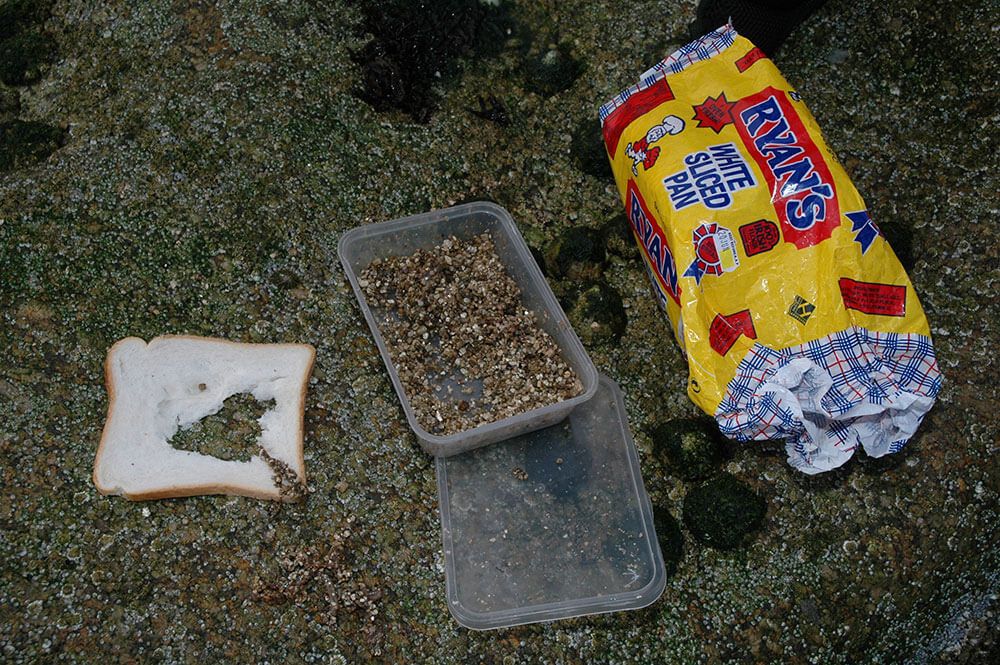
The thin-lipped mullet, compared to the thick-lip, has its own distinct characteristics and needs to be targeted as a totally separate fish.
The overall side profile shape of the thin-lip is that it is slightly slimmer in looks than the thick-lip, especially the head, but there are easier ways to ID the thin-lip. Firstly, if you bend the pectoral fin back towards the eye it will not reach the eye itself. It gets its name from the narrower front upper lip which in depth is half the length of the eye. And the other give away is the black spot at the base of the pectoral fin which thick-lipped and golden grey mullet do not have. Also, the dorsal fin is more elongated and slimmer than the thick-lip, which has a more rounded dorsal when erect.

The overall colour is usually a blueish slate grey with silver sides and a white belly. The body has lateral deeper grey stripes running the length of the body. These can be more pronounced in juvenile fish, but somewhat faint on larger adults depending on habitat.
Thin-lipped mullet have been known to exceed 10lbs in weight in the Mediterranean, but this appears to be the absolute ceiling for this species. Any UK fish over 3.5lbs would be deemed a specimen.
Thin-lipped mullet are most common in the Mediterranean, but gradually become less common as you head north into the Bay of Biscay. It is a summertime migrant to the UK’s English Channel coast but is mainly concentrated inside the river estuaries along the Hampshire, Dorset and Devon coast. Christchurch harbour in Dorset is considered the capital of thin-lipped mullet fishing due to the high numbers present.
Thin-lips have also been caught in South Wales, principally Cardiff Docks, also in the Swansea area. There is some evidence that these fish may also be in the estuaries of Pembrokeshire and Ceredigion in limited numbers, but principally inside Milford Haven. One reason information is so sketchy on this is that many anglers often don’t know the difference between thick-lipped and thin-lipped mullet.
In Ireland, thin-lipped mullet are present inside Cork Harbour and also again inside the river estuaries and saltwater lagoons of the west Cork area, especially in the Clonakilty and Union Hall regions.
There is belief that due to climate change and some rise in average sea temperatures that thin-lipped mullet are both extending their range further northwards slightly and improving in overall numbers. It’s only been in the past decade or so that thin-lips were recognised in Ireland, though again maybe some confusion in identification may be responsible.
Their season runs from April to September, but cold weather in September can see their numbers drop quickly.
They live mostly by sieving detritus from mud or scraping food organisms from weed stems and other static structure. They do not take anglers baits as easily as thick-lipped mullet do when conventional fishing, nor can they be weaned onto optional food alternatives which rarely seems to work.
They are found almost always in the main estuarial river systems sticking to the main channels where the faster currents flow. They do not, as a rule, access minor estuarial side creeks nor wander onto the open mudflats during the high tide period. They will though, travel further up the river system right into freshwater and well beyond the normal range of thick-lipped mullet.
Ideal thin-lipped mullet habitat is a saltwater lagoon that is fed twice daily by the tide but one that is not overly deep so that the sun can fully warm the water. Some weed growth is also desirable with the main composition being of soft mud. In rivers, look to the deeper pools and runs where the junction of fresh and saltwater meet.
They are a more social fish than the other two species, often forming large shoals when inside estuaries and moving in with the tide together.
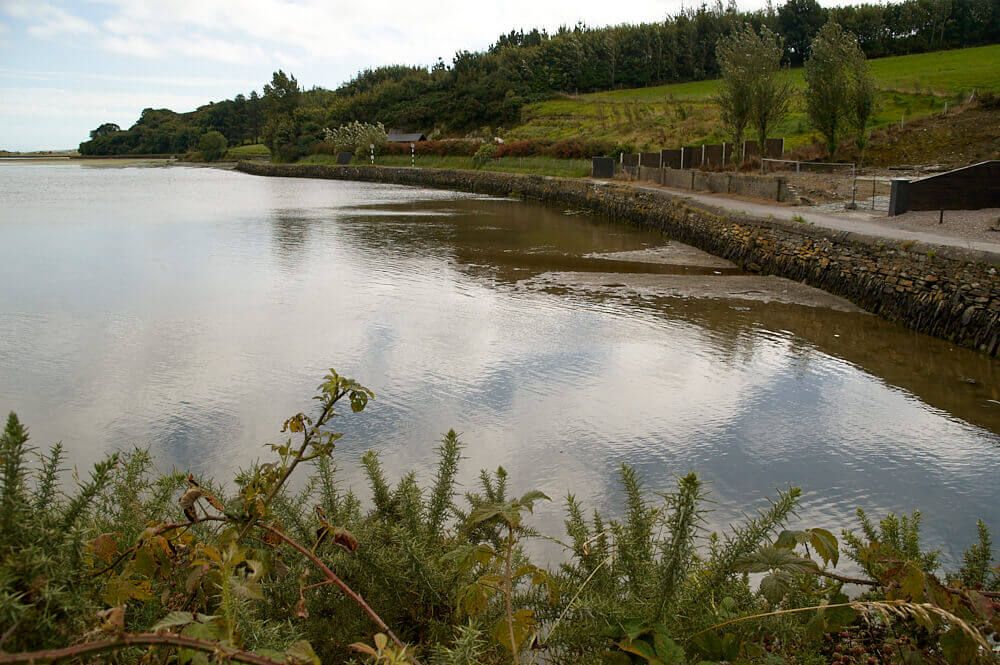
They are not overly influenced by the size of the tide. They will filter back down as the ebb tide drops but still sticking to the deeper main channels. This drop back may be only partial on the smaller neap tides and they’ll stay high up the estuary. A more marked drop back is evident during the bigger spring tides.
They feed best on the flooding tide. They tend to become less inclined to feed during the ebb tide on the majority of marks. They also have a habit of switching on and off the feed for short periods and are best described as moody.
They like relatively settled weather and will penetrate far upriver in these conditions. If the river has a higher than normal flush through of rainwater, then they will drop back to mid or lower estuary areas until it has cleared and often disappear altogether.
Very bright sunny days can make them very spooky. Overcast skies give you a much better chance, and although this species tends to feed throughout daylight, they often respond best during the early mornings and late evenings when the light levels drop accordingly.
They will feed in flat calm conditions, but a slight surface ripple is preferred, which cuts down the light levels and makes the mullet feel safer. If seagulls or shadows pass overhead, they quickly sink out of sight, though this is common with all mullet.
The already mentioned Cadence CR10 feeder rods are pretty much perfect for thin-lipped mullet, the number 2 model being ideal for general fishing. Match this to a 3500 or 4000 sized reel and load with 12lb braid line and finish with 6ft of 6lb fluorocarbon. This outfit casts lighter tackle a long way, which is often the difference between success and failure.
Similar feeder rods will do the same job, as will rods classified as “Avon” for general coarse fishing.
The most consistent method to catch this special mullet is with a form of spinning. There are two ways in which you can set up to cover all options.
If you need casting distance, which is highly likely, the best forms of weighted float are the Bombarda type with the bullet shaped heads and long tube tails. These fly like a dart and help avoid tangles in mid-flight when using longish hook lengths. If not, bubble floats work too, just not quite as well.
For shallow water, and for very shy spooky fish, the following rig works especially well.
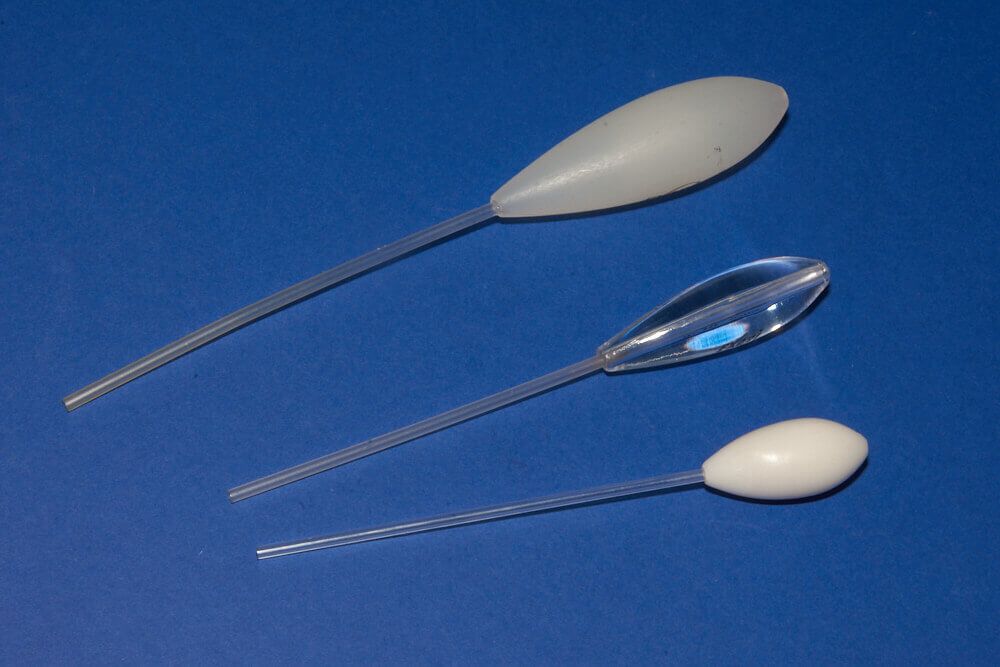
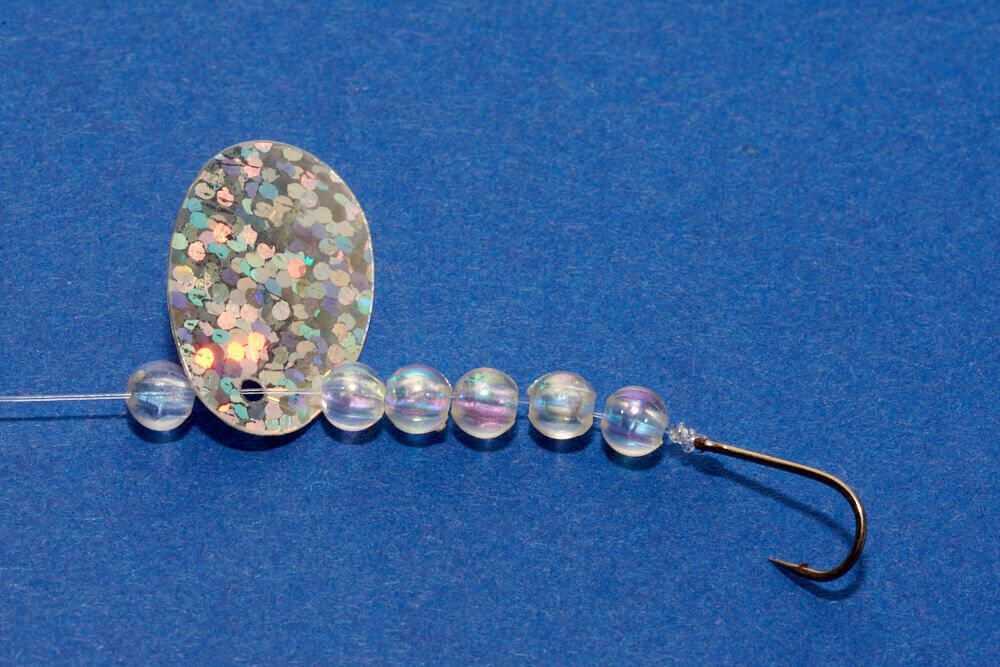 [/list]
[/list]
If the fish are working deeper and in faster tide runs, change the plastic spoon and beads for a size 3 Mepps or similar bar spoon. You need to remove the treble hook with cutters, then take about 4-inches of 12lb wire and crimp this to the base of the spinner. Now crimp on a size 6 to 8 hook to the end of the wire. The extra weight of these metal spinners take the bait down deeper to target fish working in the current.
Bait these rigs with a single maddie or harbour ragworm, but make sure the hook is threaded down through most of the body of the rag, otherwise the fish can nip the tail off and miss the hook. You can also use the artificial small ragworm soaked in enhancing liquid such as the Marukyu Isome worms in the small size.
These rigs are cast well beyond the shoaling fish, then worked through them slowly by retrieving line with the rod held low and straight at the float. Bites are rapid plucks and usually the fish hook themselves. If you get the plucks but no hook ups, try lengthening the distance of the fluorocarbon or wire below the spinner formation. Also try differing speeds of retrieve. Some tides the fish want a slowly moving bait, others faster moving baits. Also, increasing the length of wire or fluorocarbon between the spinner and the hook, anything up to 12 to 15-inches, can help induce takes.
Thin-lips can also be fussy on spinner colour, too. During bright days, small bright silver or chrome spinners work well, as can bright colours such as yellow and orange. On duller overcast days, try a more subdued colour such as gold, red or black.
The spinning methods above are far more effective than trying to target thin-lips with conventional mullet fishing tactics. Basically, if the spinners don’t get them, the likelihood is that nothing else will, either.
The golden grey mullet is the third and final member of the true mullet family that migrate and live in British and Irish waters. It is also the smallest of the three attaining a maximum weight of about 5lbs in warmer seas to the south.
It sports the typical mullet side profile body shape and also has a thin upper lip with a depth less than half the eye diameter. If the pectoral fin is extended towards the eye it will only reach and cover the rear edge of the eye, which is a quick and reliable way to ID this fish.
Its coloration is a grey slightly blue back, silver sides and a white belly with grey lengthways stripes. There is a conspicuous gold spot on the cheek and gill cover, but thick-lips can carry a golden hue mark too, so use the pectoral fin to the eye as the main ID. Also, on the golden grey, the scales in front and on top of the head end in a forwards facing dish shape. On the thin-lip these scales dish backwards, and on the thick-lip the scales end even across the top of the head.
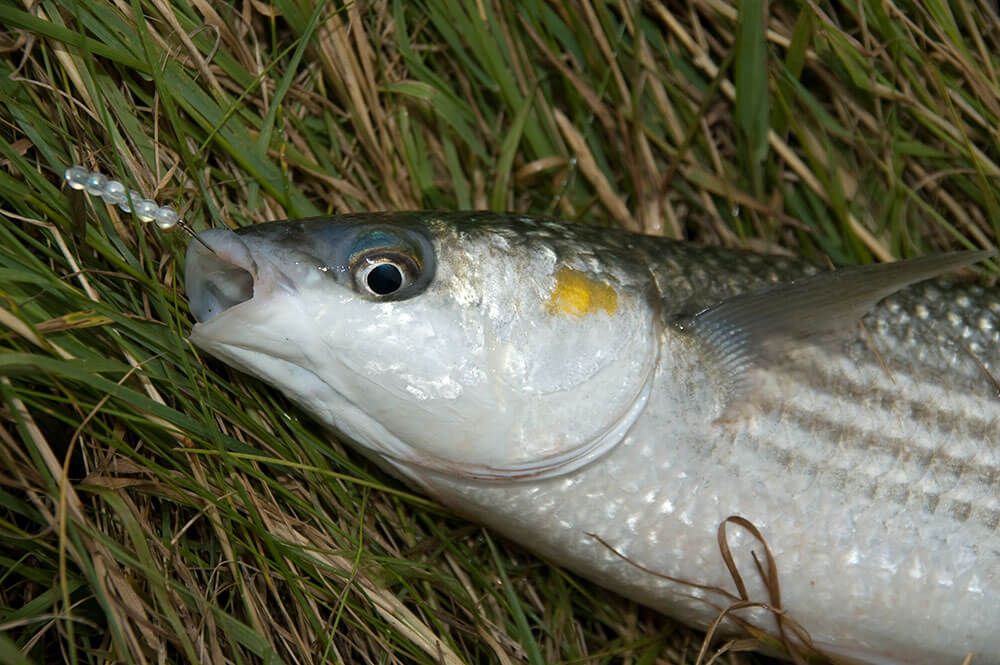
Their common range is throughout the Mediterranean, along the coasts of Spain and Portugal, the Bay of Biscay and France. They have been recorded on the Dutch and even the Norwegian coast, but these fish should be classed as occasional wanders and not regular visitors.
Golden Greys are classed as the least common of the mullet species in the UK. This is reflected in the limited areas you can catch them. Their main territory is along the southern coast of the UK as far as Kent roughly with single fish showing into Essex, but they are predominantly caught west of the Isle of Wight into Dorset, Devon and Cornwall. They also show off selected South Wales beaches around the Gower and in Pembrokeshire. This is another fish that is also caught occasionally from the mid Wales beaches in very settled and warm summers. As sea temperatures rise due to climate change, these fish are becoming more and more common this far north even though few anglers target them, but they are still classed as unusual.
In Ireland, the best mullet fishing is in Cork, especially the Clonakilty and Rosscarbery area with the collective small estuaries in this region the prime grounds.
The season for GG’s, as they are affectionately called, runs from May through to September. Come September though, they quickly start to thin out if the weather turns stormy and cold. The peak fishing is in the warmer months of May to August.
They are less choosy than thin-lips and will adapt to eat introduced food such as bread in spots where people feed birds when moving higher up into estuary lagoons. Fish working the open shoreline favour worms, small shellfish, shrimps and crabs. They, like thick and thin-lipped mullet, also eat detritus sieved from the mud they excavate.
This mullet frequents open sandy surf beaches and can be caught from the very edge of the tide line amongst the breaking waves. It also moves in and out of small estuaries that flank the beaches with the tide being found mostly in the main channels, but also breaking into the shallow mudflats at high tide and accessing saltwater lagoons that are fed by the daily tides.
They are also adaptable and can live in saltwater lagoons for weeks should they get trapped there during dropping tides until the next set of bigger tides frees them.
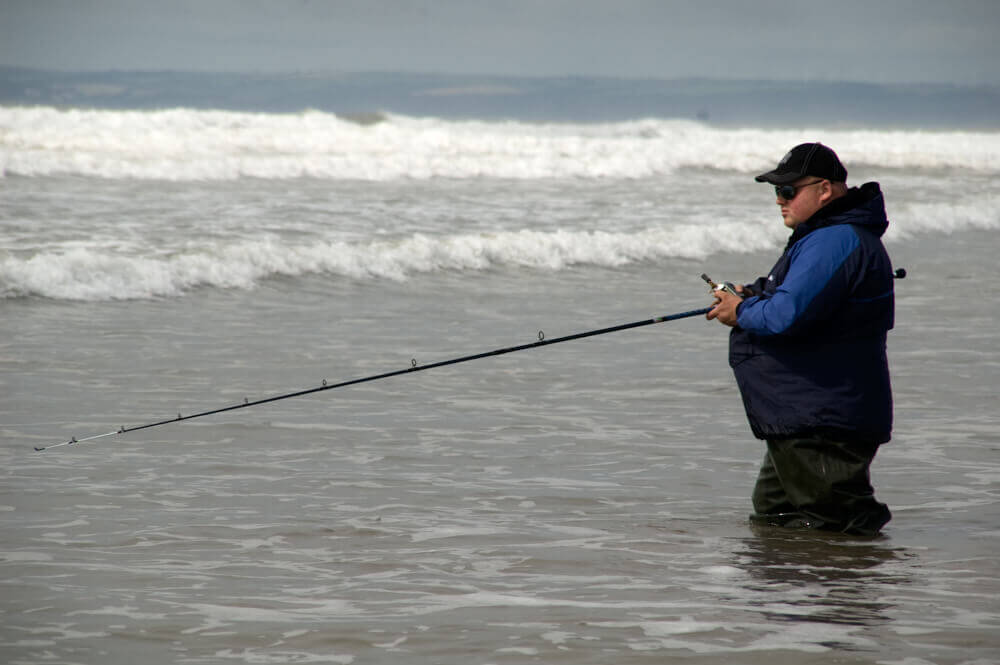
On the surf beaches they are not unduly influenced by the size of the tides but are definitely more orientated towards feeding when the bigger tides create more water movement and displace more food items. But some can still be caught even on the smallest of neap tides, if the conditions are right.
They start to run very close in, often only a few yards out in inches of water, on the beaches as soon as the flood tide starts to move. They form small shoals and are continually on the move working along the beach usually facing directly into the tide’s direction. Bites are less likely as high tide comes, and if you want to keep contact with the fish on the ebbing tide, then you’ll need to cast further, say anything up to 60yds, but rarely more.
Again, small neap tides will still see the GG’s run into the estuaries, but the bigger the tide the further they can push inland, and they will exploit this to a certain degree, but they do not generally venture as far upriver as the thick and thin-lip varieties.
Although they feed well right through the flood tide in estuaries, and they might linger briefly as the early ebb gets under way too, but once the outgoing flow quickens, they soon move back out and seem to rarely feed as they do so.
They are lovers of prolonged settled weather with calm gin clear seas, light, warm onshore winds, and gentle surfs. They need the clear water. Any coloured water after storms and windy weather will push them out and they’ll be absent until the seas settle and start to clear again.
They are daylight feeders. They will take in bright sunny weather, but the best catches usually come when there is some cloud to lower the light levels entering the water, and a light breeze to create surf or ripple the surface water also helps.
Periods of heavy rain will stop them running into the estuaries as the acidic rainwater starts to push down towards the sea. This also applies to beaches that have freshwater streams flowing across them.
The Cadence CR10 Feeder rod number 2 and a fixed spool in the 3500 to 4000 size are a sensible choice loading with the 12 to 15lb braid and fish a short fluorocarbon leader of 6 to 8lb breaking strain. They have great eyesight and the less visible fluorocarbon minimises the chance of the fish seeing the braid. Some anglers prefer to load with 6 to 8lb mainline fluorocarbon for short to medium range fishing for this visual reason. With golden grey’s rarely going over 3lbs generally, then the Cadence CR10 Feeder number 1 is a lighter choice in areas where there are no snags to maximise sport.
Golden grey mullet, like the thin-lip, respond well to spun baits. This applies both in the surf tables, and when fishing the estuaries, especially the salt lagoons. It’s the same technique using a Bombarda float, casting well beyond where you see the feeding fish, then gently drawing the bait in towards and through them. If the float splashes too near the shoal they will scatter and go off the feed and move off for some considerable time.
The bombarda float rig

 [/list]
[/list]
The little silver plastic or metal spoons work really well for this fish, but on the day, also try different colours of spoons. A good rule to work to is brighter in sunny conditions and darker on cloud days. The pearl beads work really well as they sparkle like a small fish and are light in weight and this mullet tends to take best when the lure and bait are worked at a slow to medium pace just sub surface.
Why do mullet take a bait fishing behind a spinner? More than likely is that the spinner imitates a small fish trying to flee with a food item. All fish are competitive and it’s this survival instinct that likely induces the bite.
When fishing the surf tables, the other option is to ledger fish. The best rig is a simple inline system with the weight sliding free on the main line and incorporating a hook length about 18ins in length. A worthwhile change is to use a heavier 12lb fluorocarbon leader about 6ft long. This stronger line helps combat any abrasion associated with contact with the sand and the continual travel of the lead due to surf and tide action.
This rig after casting straight out, is a good one for swinging round in an arc across and downtide therefore covering a wide area of ground helping to locate the fish which can be at very specific distances from the shore. The knack is to choose a ball weight just heavy enough to be occasionally moved by the surf and tide to give this travel. GG’s do like a bait that is moving naturally. Very static baits are less likely to be picked up. If there is little wave or tide movement evident, occasionally twitch the weight back by drawing the rod tip back towards you a foot or so and taking in the resulting slack line. Even this minimal movement of the bait can be enough to draw a take.
Some anglers add attractor beads or float beads a few inches above the hook when fishing the surf or ledger fishing and both these can work, especially the floating bead as this will rise and fall in the water tables and current giving the bait that necessary natural movement. Yellow or silver float beads seem to work well in most conditions.
Golden greys will also take floating bread fished 5ft away from either a Bombarda or bubble float in areas where birds are publicly fed. The best tactic here, is to find the fish, cast a chunk of bread flake a little smaller than a 50p piece and just leave it to drift naturally with the current. Watch the bread all the time for the sign of a take. Also, try small maddie rag and let this sink naturally to a greater depth. This method will often take fish feeding close to or on the bottom, especially in lagoons, but also on beaches when the surf is minimal in very calm weather.
The very best bait for golden grey mullet fishing is maddie or harbour ragworm. These tend to be smaller ragworm up to about 2ins or so and found in the same thick mud the mullet like to feed through.
On the surf beaches when ledger fishing, try small bunches of these worms, say three or four, maybe more, with the hook just nicked through the head end leaving the tails to wriggle. In the surf, small bits of king ragworm, lugworm, and even squid strips can work, but the maddies are the number one bait by far.
When mullet fishing with the spinner system, fish just one worm with the hook and line passed almost fully down the body. If you leave a wriggling worm tail, the fish will often nip this off and miss the hook.
The alternative bait, though not as good as live maddie, is a small section of artificial Isome worm soaked in enhancer fluid. This will work fished behind the spinner, but keep it small, say 1 to 2cms maximum, and after a few casts recharge the worm in the enhancing fluid.
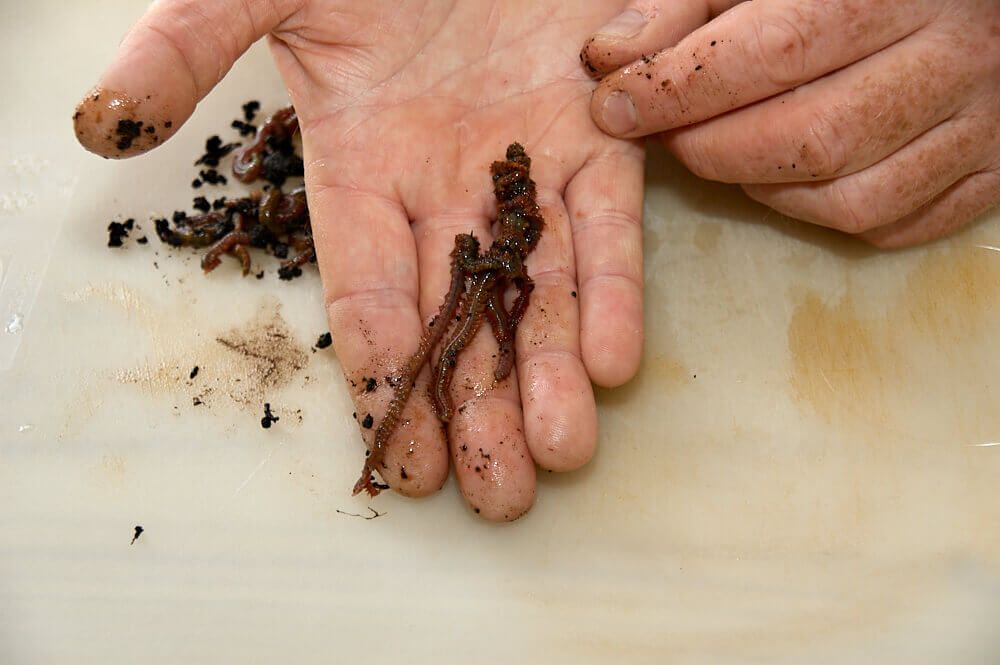
About mullet
Thick-lipped mullet are often referred to just as “grey” mullet, and sometimes as the UK’s bonefish due to their superb fighting ability, which is well deserved. A common myth is that mullet are uncatchable. Certainly, they can be very difficult to tempt at times, frustrating even, but sometimes stupidly easy, too. And in reality, that’s the fascination of them!
There are about 80 types of mullet in the world, most falling into the families Liza and Mugilidae. UK thick-lipped mullet belong to the Mugilidae genera.
Thick-lipped mullet are found right across Europe from the North African coast, throughout the Mediterranean, right up the coasts of Spain, Portugal, France, throughout the eastern side of the North Sea as far as the southern coast of Norway. Their territory also extends as far as the south-eastern tip of Iceland, though they can be classed as very rare there.
They inhabit the whole of the UK coastline and can be seen sometimes as far north as the Shetland Islands, though north of a line drawn through central Scotland they become uncommon. In Ireland, mullet are found again along the whole coastline but are commonest south of a line drawn roughly between Donegal and Dundalk, with the southern and western counties seeing the best numbers of fish.
Mullet could be classed as migratory, for although they sometimes over winter in the smaller southern, southwest of England and southern Irish estuaries, also in harbours and marinas if the weather remains mild, they normally leave the coast and head south into deeper water for the winter months.
Breeding cycle
Male mullet are thought to mature at about 9-years of age and a length of about 42cms. Females achieve adulthood at 47cms and probably 11-years of age. These mullet are thought to only see a proportion of the overall stock breed each year, and probably only in alternate years. This makes them very vulnerable to overfishing.
They spawn in inshore waters in winter and early spring with the eggs and fry pelagic and distributed evenly along the coast by prevailing tidal currents. Fin perfect first-year fish can often be found in small saltmarsh pools and shallow estuary creeks along with bass, also in shoreline rock pools after a high tide when they get stranded. Thick-lipped mullet are thought to be able to reach 25-years of age in exceptional circumstances.

In the warmer Mediterranean mullet can achieve weights to approximately 18lbs, but this is very rare. Few fish achieve double figures in reality and a 10lb fish is exceptional in UK and Irish waters. Most mullet weigh in the region of 2lbs to 4lbs in weight, with a 5lb fish being classed as a specimen in most areas.
Identifying different mullet
Grey mullet have a typical round fish body shape, the flanks are covered in large, heavy protective scales. It has a four-spined dorsal fin, and the upper lip will be more than half the eye diameter, with the lower part of the lip covered in small densely packed teeth and carrying small taste bumps called papillae.
There are two other types of common mullet, the thin-lipped mullet and the golden grey mullet. Their habitats can coincide, and anglers can find it difficult to identify the individual types, but there is an easy way.
On the thick-lip, pull the pectoral fin backwards towards the eye and the tip of the fin will reach as far as the forward edge of the eye pupil. On the golden grey, the tip of the fin will reach to the rear edge of the eye pupil, and on the thin-lip mullet, the fin brought forwards will see the edge fall fully behind the eye socket. The thin-lip also has a black spot at the base of the pectoral fin.
The majority of grey mullet are slate grey on the back shading to white on the lower flank and belly. Sometimes the fish takes on a green/blue hue and sport darker backs when living in harbours and working alongside weed-covered man-made structure. They sometimes have a hint of yellow or gold around the head too. The ventral fins can be white, with the anal fin a slight grey colour.

Thick Lipped Mullet

Golden Grey Mullet

Thin Lipped Mullet
What do mullet eat
They normally feed on plant matter, algae, nematode worms, copepods, small fish and larger worms.
Mullet will scrape their mouths along the sides of muddy creeks leaving a distinctive and visually obvious scar which is useful in finding their preferred feeding areas. In doing this, they filter out the food in the mud, then displace the unwanted mud out through the gills, it’s a form of filtering.
Mullet are an intelligent fish, well capable of working out simple problems. They are quick to take advantage of unusual but area common food items that enter their realm. Things such as waste fish scraps from commercial and charter fishing boats washing their decks off after a day’s fishing, human food waste is thrown into harbours and marinas including chips, bread, pasta and meat. They are also partial to the maggots found in rotting seaweed in high summer along the tide line of sandy and shingle beaches.
They also have a great sense of timing and will turn up close to pipes that pump natural fish waste into the sea just before the pipe switches on.
How to catch thick lipped mullet
When and where to catch thick lipped mullet
The traditional mullet season starts in April in the south of England and maybe late April in average weather years along the Welsh Coast and in southeast England. It’s often late May or even early June before they show in the more northern areas. They stay until October and even November in the south if the frosts are not severe. Their numbers peak generally, from June to September with August and September often the best months of all.
They tend to be an estuary dwelling fish not averse to travelling as far as the divide line between salt and freshwater. In estuaries they will work through the main estuary channel with the tide, then enter drainage creeks and access salt lagoons as these flood deeper with the incoming tide. Over high water, they linger in the deeper channels, but also wander freely over flooded saltmarsh if the depth of water allows.
Mullet will also frequent the open coast being seen off beaches swimming in the inner surf tables like bass, but over high water will feed along the high tide line taking maggots from rotting seaweed and sea slaters in summer. They can also be found off open rock marks feeding inside small bays and in amongst weed beds.
Thick-lipped mullet are a shoal fish but are usually in smaller groups or individual fish when accessing creeks and smaller bays. They can often be seen with their mouths dimpling the surface or head and fin making a V wake as they power forward. This is distinctive and again a giveaway as to where they patrol and feed.

How to find fish holding feature
Small working harbours and marinas are one of the best places to see mullet cruising and feeding. They show on the surface with their typical V wake indicating their swimming direction. They are quick learners and will stay outside the harbour confines until the boats head in, in the evenings then suddenly appear and begin to feed on the scraps and fish bits that enter the water as the boats unload and clean down. If you’re allowed to fish right in amongst the boats and their mooring ropes tight alongside the boats when the activity dies down a little, you can enjoy some great sport.

In shallower harbours that all but dry out at low water, the mullet will filter in with the tide as soon as there is enough depth for them to swim in, but equally will move out fast as the tide ebbs.
Also try alongside the harbour walls, especially if there are tourists about and parents and children using crab lines. The food that gets thrown in or blown into the water, plus the bait used for crab lines becomes a natural ground bait that will hold the mullet’s attention.
Another good spot is where shallow mud flanks up to seaweed along the shore next to harbours. If you’re quiet and keep your shadow and silhouette off the water, you will often see the mullet cruising these edges in just inches of water, their backs fully above the surface.
In marinas, again not all allow fishing, the mullet will be ever-present due to the greater depth. Their typical haunt is in the shadow of either the boats or working right under the pontoons nosing in amongst the weed growth on the supports. You need to walk lightly so as not to disturb the fish under the pontoons and baits need to be placed to look as if they have fallen in naturally.

Thick-lips also frequent breakwaters, piers and jetties. They will be seen free swimming along the edges of such man-made structures, and often have a particular route they patrol when feeding. Some of the best areas, if you are allowed to fish them, are where the structure has a bend in it, or where the weed grows along the low water line. They will also feed on the growth that is found on jetty and pier pilings right underneath the structure.
Some breakwaters have outlet pipes that filter off waste from commercial fishing process plants. If you can find such a place, then it's likely the mullet will be there in great numbers and you’ll see them on the surface and also watch them swimming right up to and even into the pipe itself.

Mullet use the flooding tide to access all areas of an estuary environment. They will follow the shallow side creeks that drain the flood tide off, lingering in small indentations in the bankside, also working through weed growth. They also access the upper salt marsh creeks and weed beds and love the deeper pools where maybe a sluice gate draining off land water enters the creek and forms a deeper pool. They will swim right into the junction line where saltwater meets freshwater, so no area is out of bounds to the inquisitive mullet.
Other good estuary spots are where small muddy bays form, often with weed along the low water line. Mullet work the bays fully and again can be seen cruising. Also places where small streams wash into the estuary or areas where drainage water seeps back seaward.

From mid-summer, mullet will also be found working the ends of beaches and inside small seaward facing bays. The best time to fish these is when there has been an onshore wind and there is an accumulation of seaweed along the high tide mark. The seaweed rots and becomes filled with wriggling maggots. As the flood tide reaches the tide line, the maggots continually wash into the sea forming the very best groundbait and the mullet will move in, in numbers and can, at times, be suicidal in taking maggots. This is typically in the late July through to early October period and works best in calm seas with light surf.
Grey mullet can also be found off open rock marks facing into the open sea. This is especially common in the Channel Islands, off the Devon and Cornish coast, off Wales and along the Irish south and southwest coast.
Tides for thick lipped mullet
Tides are not so important in many cases regarding mullet compared to other fish. Estuary and harbour mullet will feed most tides, both big and small. They also work up the estuaries and into the side creeks but obviously on the smaller tides the ground they can access is more limited.
Estuarial mullet will stay in the deeper brackish pools at the heads of estuaries until the next tide returns, but fish feeding in the salt marsh creeks will move in with the flooding tide, linger over high water, but by the first hour of the ebbing tide will be dropping back quickly to the main estuary channel.
Depth is the motivator for moving regards harbour and breakwater mullet. They feed best during the flood tide but again will move out and often disappear as the ebb tide starts to run, though this can be depth driven. In deeper water, they will linger longer or not move far at all.
Weather patterns for thick lipped mullet
Mullet are caught in daylight, also at dusk and dawn, but almost never in full dark when they seem to go semi-comatose and refuse to obviously feed. They can be the odd exception when bright streetlights are right by the waterside. Sometimes, mullet will feed in this artificial light if there is an obvious and consistent food source available to them. This is rare though.
They will take in bright sunlight, but generally, the better conditions are an overcast sky and a light breeze enough to ripple the surface water to cut down on light levels which seems to make the mullet feel more secure and willing to feed.
Mullet like relatively calm weather when working in shallower water. In deeper water, say inside marinas and harbours, then although you maybe can’t see them, they will often be feeding on the bottom in rougher weather, again this will be reliant on a natural or artificial food supply being available.
In very rough weather, stick only to deeper harbours and marinas, or high up the estuary towards the freshwater line. That said, mullet do not like heavily coloured acidic water caused by heavy rain over the mountains or moors.
Tackle for thick lipped mullet
Ledger and feeder fishing
Targeting mullet when close to tied up boats, mooring buoys, ropes and other harbour obstructions, also when fishing marina pontoons and breakwaters, the fighting abilities of mullet need to be taken into consideration with strong tackle required to keep the fish away from the snags, if possible.
For this type of fishing the modern freshwater feeder rods, such as the 11ft Cadence CR10 Feeder number 2 or number 3 are a good choice being a medium and stronger action respectively. They are supplied with three tips covering casting weights 1oz, 1.5oz and 2oz, so cover most mullet situations. These have a soft tip and upper mid-section, which helps to cushion the lunges of the fish, but there is real power in the lower mid-section and butt that aids casting but also adds the necessary power in the rod to turn and tire big powerful fish. This is the best choice when feeder fishing or light ledger fishing, and also for casting bubble floats with bread baits.
Fixed spool reels in sizes 3500 or 4000 are ideal loaded with 12 to 15lb braid. The braid, having no stretch, helps you apply heavy direct pressure to the fish and helps you turn it away from any obstacles. It also, in theory, lessens the time it takes to tighten into the fish, which can be an advantage when after mullet. That said, mullet can be very line shy, so when using braid, always fish a short 5 or 6ft section of 6 to 8lb fluorocarbon. Alternatively, load with a full fluorocarbon mainline in 6 to 8lbs and fish it straight through.
Feeder fishing with either open-ended cage feeders, or better still the Guru mould type feeders, works very well. You can load these with a bread mix, or liquidised bread and light groundbait mix, possibly with a few maggots added or flakes of mackerel. Keep the hook length short, no more than 6-inches and make it from fluorocarbon so there is a little stiffness there. Hook size should be a size 8, say a Drennan Super Specialist for strength. Bait with a small flake of bread, or a couple of maggots if they are in the groundbait.

Make sure you cast to the same place each time by putting the line in the line clip. This helps keep a little bait trickling out in the same area and will help to keep the mullet interested. Bites will be a single solid pull round of the rod tip. These fish often self-hook, but to make sure, lift the rod up and just tighten into the fish. Do not strike as this can either pull a light hook hold free or snap a light hook link.
To ledger fish, a good set up is to just use a sliding ledger, the weight free to slide on the mainline, stopped by a rubber bead and a tied-on swivel, then use 12 to 18-inches of 6lb fluorocarbon and a size 8 hook. This works well if you’re able to groundbait from above and can keep the groundbait and rig in the same vicinity. Bite detection is excellent as the hook and line are direct to the rod tip.
Bubble float fishing
This is one of the most successful ways to fish for mullet using bread. Choose, if possible, the oval-shaped bubble floats sliding this up the fluorocarbon leader or mainline and lock it in place. Add a little water for casting weight, if needed. The hook length needs to be 6lb fluorocarbon and anything between 3 and 5-feet. Go shorter for longer range and longer for casting close. The hook is tied direct to the fluorocarbon and should be a size 8 Drennan Super Specialist.
Scatter no more than half a dozen 50p sized free offering bits of bread onto the surface in the vicinity of the cruising mullet. Try to be patient and let them get confident in feeding on the bread. Keep adding two or three bits of bread to keep it going. Once the fish are feeding constantly, pinch on a 50p size piece of bread, crimp it around the hook length directly above the hook, then hide the hook point by enclosing the hook in the bread and crimping the edges with your fingers. This hiding of the hook secures the bait better but can make a big difference when the fish are in totally clear water and visually capable of spotting the hook and realising something isn’t right, which they do often. The hook pulls easily through the bread when you strike, anyway.

Try to anticipate where the fish are going to be. Don’t cast straight at them as this will just put them down and spook them. Study the patrol route of the fish and place the bait where they are likely to swim too, or, cast well over them and then draw the bait in slowly a foot at a time.
For bite detection, you have the choice of watching the bread bait on the surface, waiting for the swirl as the mullet sucks it in, count to two, then lift into the fish. Alternatively, watch the bubble float and when it slides across the surface, strike. Once you have the knack, watching the bread is the best way.
Our Sea Fishing Rigs section has a step by step guide to making a Mullet Bubble Float Rig.
Float fishing
For float fishing, look to a freshwater float rod, something like the Cadence 12 or 13ft options. Again, they have a forgiving action but offer real power low down to fight heavier fish with. A good reel for this rod would be a size 3000 fixed spool reel and load with 4 to 5lb mono in a clear or clear brown colour, both these lines seem to camouflage better in the water.
The best floats are the loaded Crystal Wagglers used in coarse fishing. They are long and well balanced and will, in the appropriate sizes, cast a long way and sit well even in windy driven surface water. They can be rigged by positioning float stops either side of the float on the mainline, so you have instant depth adjustment. These need to grip though, so if in doubt add two float stops back to back at either side. In shallow water, add a couple of very small shot to get the float to sit just proud of the surface, but also to gently let the bait sink down naturally. The natural drop of the bait can be key when float fishing, so keep this in mind. In fact, if you know mullet are present and you’re not getting takes, try adding or removing shot to within 15-inches of the hook until you find the drop speed they want.

Mullet can be depth specific when it comes to taking baits, so adjust the depth of the float up and down by 6-inches until you start to get takes.
Also, as when bubble float fishing, try to cast over the fish and then gently draw the float in towards them to avoid spooking them.
Drop down mackerel technique
This is a very effective and quick method to get mullet feeding alongside a harbour wall or when fishing piers and jetties.
Rig up as before with a feeder rod, 3500 to 4000 sized fixed spool reel, 15lb braid and a short 10lb fluorocarbon leader. To the end of the leader tie on a size 6 rolling swivel. The hook length is 12-inches of 6lb fluorocarbon and tie on a size 8 Drennan Super Specialist hook or similar pattern. To the larger size 6 swivel tie on a short 6-inch section of 20lb mono and a size 2/0 hook.
Take a whole ideally fresh mackerel and cut it into three equal sections. Push the 2/0 hook well into one of the sections, the head and middle body sections are best for this. This is not to catch fish but purely to hold the mackerel section in place. Bait the size 8 hook with a small sliver of mackerel just enough to hide the hook.
Drop the mackerel section and bait hook over the side of the harbour wall but keep it as close to the wall as you can. Give it a little shake now and then to release little bits of fish that will fall off and drop down through the water column. Mullet will find and follow this trail of smell and food bits and eventually see the baited hook which looks just like a small bit of fish falling off the main section and take the bait without fear. This method works especially well where commercial boats and charter boats dock in the evenings, but it will work at all other times too.
Rock fishing
Open coast rock fishing can be hit and miss but tends to produce a better than average size of fish. By open coast it means rock ledges that give in to fairly deep water. It surprises many that mullet are living here, but you can often see small shoals of them pass by when fishing for other species.
You need to make a semi liquid chum. This can be any minced-up fish but oily fish like mackerel or tins of tuna, pilchards and sardines work best. Smash these up then add liquidised bread or bran. The bran is good as it soaks up the blood and juice and will filter down through all levels of the water column. It matters not if this brew is left to go “high” for a couple of days.
Choose a spot on the rocks where you have access to land fish easily. Also, one where you can fish well back from the water, so you are not easily seen. Float fishing with small mackerel baits is the best tactic, but you might need to use bigger cigar shaped floats rather than normal Waggler floats due to the sea swell. These are simply rigged by sliding a 5mm bead on to the main line, then the float, a ball-weight big enough to cock the float, another 5mm bead then tie on a size 6 rolling swivel. The hook trace is 18-inches of 8lb fluorocarbon with a size 8 hook attached. Keep the float as small as is sensible and add enough weight to have it just proud of the surface. If it occasionally bobs under in the swell, it does not matter.
Use a soup ladle to throw the groundbait mix into the sea. It only needs to be dropped in really as the sea swell will carry the groundbait outwards. At first throw in three of four ladles full, then wait a minute and add another. Do this for 20 to 30 minutes, then start to fish, but keep throwing in some groundbait every few minutes. This will draw any mullet into the area, but also induce bites from wrasse and pollack too, so sport can be lively.
Groundbaiting
The real key to getting mullet to feed is to apply ground bait. This need be nothing more than liquidised bread, which will work well on its own when fishing harbours and estuaries, but is even better if you had either a tin of tuna or mackerel in sunflower oil, which works really well especially when float-fishing as it hangs in the water column better due to the oil.
If you choose somewhere you want to fish, then find a spot where you can have a small bag hanging in the water uptide of where the fish usually feed, this is perfect. The trail of food particles trickling off downtide will draw the fish in and you trot a bait down on a float to give perfect presentation. In deeper water, form the bread mix into small golf ball sized balls and throw these in so they sink before breaking up. This will need to be a firm mix just stiff enough to hold together.
What does work well is to not fish for a few days but apply the groundbait exactly where you want to fish from every day at the exact same stage of the tide. Note we said, “same stage of tide”, not the same time. This is important and educates the fish to expect food at a certain spot at a certain time of tide and once you begin to fish it can produce some excellent catches.

What are the best baits for thick lipped mullet
As we’ve seen, bread is one of the best baits as the mullet come in contact with it regularly during their tidal migrations due to people throwing it in for ducks and other wild fowl as well as sandwiches thrown from harbour walls.
Other baits that work well for mullet are maddie or harbour rag, very small bits of mackerel if you’re fishing by boats or have groundbait with mashed up mackerel or tuna in, small chunks of king ragworm, which can be deadly in harbours and when ledger fishing, also, in harbours and marinas, small bits of meat such as tiny bits of ham or pork as these will be thrown into the water naturally by boaters. Squid can work too, as will maggots, and sometimes small cubes of cheese.
It’s a fact that mullet can be weaned on to any bait, pretty much, if you keep a regular supply going in and feed at the same stage of tide until they accept the food as a natural.

Top tips for thick lipped mullet fishing
- There is some truth that if you can see mullet constantly cruising, then they are not feeding intently. They may take a bait, but the better strategy is to first locate the fish visually, then wait for them to disappear indicating they have dropped deeper down to feed.
- At longer range, a float with a black tip is often easier to see than one painted orange, red, yellow or white. Black also stands out better if there are tiny white wavelets breaking in a choppy sea.
- When ground baiting, do it on the little and often system. This keeps the fish feeding and concentrated in one relatively small area and makes targeting them much easier.
- Practice as much stealth and concealment as you can when after mullet, especially creek mullet which can be ultra-cautious and spooky. Keep any noise to a minimum, try not to cast shadows with your rod over the water when casting, and if need be, cast from a laid down position to keep your silhouette from spooking the fish. If you spook cruising mullet, keep out of sight for 10 to 15 minutes and they’ll usually come back on the feed.
- Always carry a landing net and net the fish. Hook holds can be fragile when mullet fishing simply because they feed cautiously and due to the small size of the hook usually required. Use the net and you’ll land far more mullet.
How to catch thin lipped mullet
The thin-lipped mullet, compared to the thick-lip, has its own distinct characteristics and needs to be targeted as a totally separate fish.
Identification of thin lipped mullet
The overall side profile shape of the thin-lip is that it is slightly slimmer in looks than the thick-lip, especially the head, but there are easier ways to ID the thin-lip. Firstly, if you bend the pectoral fin back towards the eye it will not reach the eye itself. It gets its name from the narrower front upper lip which in depth is half the length of the eye. And the other give away is the black spot at the base of the pectoral fin which thick-lipped and golden grey mullet do not have. Also, the dorsal fin is more elongated and slimmer than the thick-lip, which has a more rounded dorsal when erect.

The overall colour is usually a blueish slate grey with silver sides and a white belly. The body has lateral deeper grey stripes running the length of the body. These can be more pronounced in juvenile fish, but somewhat faint on larger adults depending on habitat.
Thin-lipped mullet have been known to exceed 10lbs in weight in the Mediterranean, but this appears to be the absolute ceiling for this species. Any UK fish over 3.5lbs would be deemed a specimen.
Where and when to catch thin lipped mullet
Thin-lipped mullet are most common in the Mediterranean, but gradually become less common as you head north into the Bay of Biscay. It is a summertime migrant to the UK’s English Channel coast but is mainly concentrated inside the river estuaries along the Hampshire, Dorset and Devon coast. Christchurch harbour in Dorset is considered the capital of thin-lipped mullet fishing due to the high numbers present.
Thin-lips have also been caught in South Wales, principally Cardiff Docks, also in the Swansea area. There is some evidence that these fish may also be in the estuaries of Pembrokeshire and Ceredigion in limited numbers, but principally inside Milford Haven. One reason information is so sketchy on this is that many anglers often don’t know the difference between thick-lipped and thin-lipped mullet.
In Ireland, thin-lipped mullet are present inside Cork Harbour and also again inside the river estuaries and saltwater lagoons of the west Cork area, especially in the Clonakilty and Union Hall regions.
There is belief that due to climate change and some rise in average sea temperatures that thin-lipped mullet are both extending their range further northwards slightly and improving in overall numbers. It’s only been in the past decade or so that thin-lips were recognised in Ireland, though again maybe some confusion in identification may be responsible.
Their season runs from April to September, but cold weather in September can see their numbers drop quickly.
What do thin lipped mullet eat
They live mostly by sieving detritus from mud or scraping food organisms from weed stems and other static structure. They do not take anglers baits as easily as thick-lipped mullet do when conventional fishing, nor can they be weaned onto optional food alternatives which rarely seems to work.
What is the habitat of thin lipped mullet
They are found almost always in the main estuarial river systems sticking to the main channels where the faster currents flow. They do not, as a rule, access minor estuarial side creeks nor wander onto the open mudflats during the high tide period. They will though, travel further up the river system right into freshwater and well beyond the normal range of thick-lipped mullet.
Ideal thin-lipped mullet habitat is a saltwater lagoon that is fed twice daily by the tide but one that is not overly deep so that the sun can fully warm the water. Some weed growth is also desirable with the main composition being of soft mud. In rivers, look to the deeper pools and runs where the junction of fresh and saltwater meet.
They are a more social fish than the other two species, often forming large shoals when inside estuaries and moving in with the tide together.

Tides for thin lipped mullet
They are not overly influenced by the size of the tide. They will filter back down as the ebb tide drops but still sticking to the deeper main channels. This drop back may be only partial on the smaller neap tides and they’ll stay high up the estuary. A more marked drop back is evident during the bigger spring tides.
They feed best on the flooding tide. They tend to become less inclined to feed during the ebb tide on the majority of marks. They also have a habit of switching on and off the feed for short periods and are best described as moody.
The best weather patterns for thin lipped mullet
They like relatively settled weather and will penetrate far upriver in these conditions. If the river has a higher than normal flush through of rainwater, then they will drop back to mid or lower estuary areas until it has cleared and often disappear altogether.
Very bright sunny days can make them very spooky. Overcast skies give you a much better chance, and although this species tends to feed throughout daylight, they often respond best during the early mornings and late evenings when the light levels drop accordingly.
They will feed in flat calm conditions, but a slight surface ripple is preferred, which cuts down the light levels and makes the mullet feel safer. If seagulls or shadows pass overhead, they quickly sink out of sight, though this is common with all mullet.
Tackle for thin lipped mullet
The already mentioned Cadence CR10 feeder rods are pretty much perfect for thin-lipped mullet, the number 2 model being ideal for general fishing. Match this to a 3500 or 4000 sized reel and load with 12lb braid line and finish with 6ft of 6lb fluorocarbon. This outfit casts lighter tackle a long way, which is often the difference between success and failure.
Similar feeder rods will do the same job, as will rods classified as “Avon” for general coarse fishing.
Rigs and techniques
The most consistent method to catch this special mullet is with a form of spinning. There are two ways in which you can set up to cover all options.
If you need casting distance, which is highly likely, the best forms of weighted float are the Bombarda type with the bullet shaped heads and long tube tails. These fly like a dart and help avoid tangles in mid-flight when using longish hook lengths. If not, bubble floats work too, just not quite as well.
For shallow water, and for very shy spooky fish, the following rig works especially well.
- Slide on the Bombarda float, then a bead and tie on a small swivel.
- On to the swivel tie on 4 to 6ft of 6lb fluorocarbon.
- Slide on a 3mm pearl bead, then a small silver plastic spinner blade mounted on a clevis pin so it spins freely. The clevis pin is optional, but a freely rotating blade can make a difference on the day.
- Slide on three more pearl beads.
- Tie a small size 8 swivel to the end of the fluorocarbon leader.
- Tie on to the free eye of the swivel, 5 to 6-inches of 6lb fluorocarbon line and a size 6 to 8 Drennan Super Specialist hook.


If the fish are working deeper and in faster tide runs, change the plastic spoon and beads for a size 3 Mepps or similar bar spoon. You need to remove the treble hook with cutters, then take about 4-inches of 12lb wire and crimp this to the base of the spinner. Now crimp on a size 6 to 8 hook to the end of the wire. The extra weight of these metal spinners take the bait down deeper to target fish working in the current.
Bait these rigs with a single maddie or harbour ragworm, but make sure the hook is threaded down through most of the body of the rag, otherwise the fish can nip the tail off and miss the hook. You can also use the artificial small ragworm soaked in enhancing liquid such as the Marukyu Isome worms in the small size.
These rigs are cast well beyond the shoaling fish, then worked through them slowly by retrieving line with the rod held low and straight at the float. Bites are rapid plucks and usually the fish hook themselves. If you get the plucks but no hook ups, try lengthening the distance of the fluorocarbon or wire below the spinner formation. Also try differing speeds of retrieve. Some tides the fish want a slowly moving bait, others faster moving baits. Also, increasing the length of wire or fluorocarbon between the spinner and the hook, anything up to 12 to 15-inches, can help induce takes.
Thin-lips can also be fussy on spinner colour, too. During bright days, small bright silver or chrome spinners work well, as can bright colours such as yellow and orange. On duller overcast days, try a more subdued colour such as gold, red or black.
The spinning methods above are far more effective than trying to target thin-lips with conventional mullet fishing tactics. Basically, if the spinners don’t get them, the likelihood is that nothing else will, either.
Top tips for catching thin lipped mullet
- Thin-lips are very spooky and are easily frightened, neither do they return to feeding as quickly as thick-lipped mullet will. For this reason, make sure you use every scrap of cover you can on the bankside. Do not hold rods high but keep them low to avoid casting shadows. Also keep noise down to a minimum if the fish are close to you.
- Try changing the colour of the artificial ragworm baits if bites are hard to come by. The natural red is good, but if this does not work try a bright white as this can sometimes shock a fish into biting.
- If you’re getting no takes to a steady retrieve, just for a few seconds stop retrieving and let the spinner fall a few inches in the water column, then pick up the retrieve again. This stop start action often sees otherwise inert fish suddenly attack immediately the spinner starts to rotate again and the bait lifts in the water.
How to fish for golden grey mullet
The golden grey mullet is the third and final member of the true mullet family that migrate and live in British and Irish waters. It is also the smallest of the three attaining a maximum weight of about 5lbs in warmer seas to the south.
How to identify golden grey mullet
It sports the typical mullet side profile body shape and also has a thin upper lip with a depth less than half the eye diameter. If the pectoral fin is extended towards the eye it will only reach and cover the rear edge of the eye, which is a quick and reliable way to ID this fish.
Its coloration is a grey slightly blue back, silver sides and a white belly with grey lengthways stripes. There is a conspicuous gold spot on the cheek and gill cover, but thick-lips can carry a golden hue mark too, so use the pectoral fin to the eye as the main ID. Also, on the golden grey, the scales in front and on top of the head end in a forwards facing dish shape. On the thin-lip these scales dish backwards, and on the thick-lip the scales end even across the top of the head.

Where and when to fish for golden grey mullet
Their common range is throughout the Mediterranean, along the coasts of Spain and Portugal, the Bay of Biscay and France. They have been recorded on the Dutch and even the Norwegian coast, but these fish should be classed as occasional wanders and not regular visitors.
Golden Greys are classed as the least common of the mullet species in the UK. This is reflected in the limited areas you can catch them. Their main territory is along the southern coast of the UK as far as Kent roughly with single fish showing into Essex, but they are predominantly caught west of the Isle of Wight into Dorset, Devon and Cornwall. They also show off selected South Wales beaches around the Gower and in Pembrokeshire. This is another fish that is also caught occasionally from the mid Wales beaches in very settled and warm summers. As sea temperatures rise due to climate change, these fish are becoming more and more common this far north even though few anglers target them, but they are still classed as unusual.
In Ireland, the best mullet fishing is in Cork, especially the Clonakilty and Rosscarbery area with the collective small estuaries in this region the prime grounds.
The season for GG’s, as they are affectionately called, runs from May through to September. Come September though, they quickly start to thin out if the weather turns stormy and cold. The peak fishing is in the warmer months of May to August.
What do golden grey mullet eat
They are less choosy than thin-lips and will adapt to eat introduced food such as bread in spots where people feed birds when moving higher up into estuary lagoons. Fish working the open shoreline favour worms, small shellfish, shrimps and crabs. They, like thick and thin-lipped mullet, also eat detritus sieved from the mud they excavate.
What habitat do golden grey mullet like
This mullet frequents open sandy surf beaches and can be caught from the very edge of the tide line amongst the breaking waves. It also moves in and out of small estuaries that flank the beaches with the tide being found mostly in the main channels, but also breaking into the shallow mudflats at high tide and accessing saltwater lagoons that are fed by the daily tides.
They are also adaptable and can live in saltwater lagoons for weeks should they get trapped there during dropping tides until the next set of bigger tides frees them.

What are the best tides for golden grey mullet
On the surf beaches they are not unduly influenced by the size of the tides but are definitely more orientated towards feeding when the bigger tides create more water movement and displace more food items. But some can still be caught even on the smallest of neap tides, if the conditions are right.
They start to run very close in, often only a few yards out in inches of water, on the beaches as soon as the flood tide starts to move. They form small shoals and are continually on the move working along the beach usually facing directly into the tide’s direction. Bites are less likely as high tide comes, and if you want to keep contact with the fish on the ebbing tide, then you’ll need to cast further, say anything up to 60yds, but rarely more.
Again, small neap tides will still see the GG’s run into the estuaries, but the bigger the tide the further they can push inland, and they will exploit this to a certain degree, but they do not generally venture as far upriver as the thick and thin-lip varieties.
Although they feed well right through the flood tide in estuaries, and they might linger briefly as the early ebb gets under way too, but once the outgoing flow quickens, they soon move back out and seem to rarely feed as they do so.
What weather patterns to look for
They are lovers of prolonged settled weather with calm gin clear seas, light, warm onshore winds, and gentle surfs. They need the clear water. Any coloured water after storms and windy weather will push them out and they’ll be absent until the seas settle and start to clear again.
They are daylight feeders. They will take in bright sunny weather, but the best catches usually come when there is some cloud to lower the light levels entering the water, and a light breeze to create surf or ripple the surface water also helps.
Periods of heavy rain will stop them running into the estuaries as the acidic rainwater starts to push down towards the sea. This also applies to beaches that have freshwater streams flowing across them.
What tackle to use for golden grey mullet
The Cadence CR10 Feeder rod number 2 and a fixed spool in the 3500 to 4000 size are a sensible choice loading with the 12 to 15lb braid and fish a short fluorocarbon leader of 6 to 8lb breaking strain. They have great eyesight and the less visible fluorocarbon minimises the chance of the fish seeing the braid. Some anglers prefer to load with 6 to 8lb mainline fluorocarbon for short to medium range fishing for this visual reason. With golden grey’s rarely going over 3lbs generally, then the Cadence CR10 Feeder number 1 is a lighter choice in areas where there are no snags to maximise sport.
The best rigs and techniques to catch golden grey mullet
Golden grey mullet, like the thin-lip, respond well to spun baits. This applies both in the surf tables, and when fishing the estuaries, especially the salt lagoons. It’s the same technique using a Bombarda float, casting well beyond where you see the feeding fish, then gently drawing the bait in towards and through them. If the float splashes too near the shoal they will scatter and go off the feed and move off for some considerable time.
The bombarda float rig
- Slide on the Bombarda float, then a bead and tie on a small swivel.
- On to the swivel tie on 4 to 6ft of 6lb fluorocarbon.
- Slide on a 3mm pearl bead, then a small silver plastic spinner blade mounted on a clevis pin so it spins freely. The clevis pin is optional, but a freely rotating blade can make a difference on the day.
- Slide on three more pearl beads.
- Tie a small size 8 swivel to the end of the fluorocarbon leader.
- Tie on to the free eye of the swivel, 5 to 6-inches of 6lb fluorocarbon line and a size 6 to 8 Drennan Super Specialist hook.


The little silver plastic or metal spoons work really well for this fish, but on the day, also try different colours of spoons. A good rule to work to is brighter in sunny conditions and darker on cloud days. The pearl beads work really well as they sparkle like a small fish and are light in weight and this mullet tends to take best when the lure and bait are worked at a slow to medium pace just sub surface.
Why do mullet take a bait fishing behind a spinner? More than likely is that the spinner imitates a small fish trying to flee with a food item. All fish are competitive and it’s this survival instinct that likely induces the bite.
When fishing the surf tables, the other option is to ledger fish. The best rig is a simple inline system with the weight sliding free on the main line and incorporating a hook length about 18ins in length. A worthwhile change is to use a heavier 12lb fluorocarbon leader about 6ft long. This stronger line helps combat any abrasion associated with contact with the sand and the continual travel of the lead due to surf and tide action.
Rigging a sliding ledger
- On to the leader, slide on a round lead bullet.
- Slide on a size 5mm bead and tie on a size 8 rolling swivel.
- To the free end of the swivel add 18ins of 6lb fluorocarbon and a size 6 Aberdeen hook.
This rig after casting straight out, is a good one for swinging round in an arc across and downtide therefore covering a wide area of ground helping to locate the fish which can be at very specific distances from the shore. The knack is to choose a ball weight just heavy enough to be occasionally moved by the surf and tide to give this travel. GG’s do like a bait that is moving naturally. Very static baits are less likely to be picked up. If there is little wave or tide movement evident, occasionally twitch the weight back by drawing the rod tip back towards you a foot or so and taking in the resulting slack line. Even this minimal movement of the bait can be enough to draw a take.
Some anglers add attractor beads or float beads a few inches above the hook when fishing the surf or ledger fishing and both these can work, especially the floating bead as this will rise and fall in the water tables and current giving the bait that necessary natural movement. Yellow or silver float beads seem to work well in most conditions.
Golden greys will also take floating bread fished 5ft away from either a Bombarda or bubble float in areas where birds are publicly fed. The best tactic here, is to find the fish, cast a chunk of bread flake a little smaller than a 50p piece and just leave it to drift naturally with the current. Watch the bread all the time for the sign of a take. Also, try small maddie rag and let this sink naturally to a greater depth. This method will often take fish feeding close to or on the bottom, especially in lagoons, but also on beaches when the surf is minimal in very calm weather.
What baits for golden grey mullet
The very best bait for golden grey mullet fishing is maddie or harbour ragworm. These tend to be smaller ragworm up to about 2ins or so and found in the same thick mud the mullet like to feed through.
On the surf beaches when ledger fishing, try small bunches of these worms, say three or four, maybe more, with the hook just nicked through the head end leaving the tails to wriggle. In the surf, small bits of king ragworm, lugworm, and even squid strips can work, but the maddies are the number one bait by far.
When mullet fishing with the spinner system, fish just one worm with the hook and line passed almost fully down the body. If you leave a wriggling worm tail, the fish will often nip this off and miss the hook.
The alternative bait, though not as good as live maddie, is a small section of artificial Isome worm soaked in enhancer fluid. This will work fished behind the spinner, but keep it small, say 1 to 2cms maximum, and after a few casts recharge the worm in the enhancing fluid.

Top tips for catching golden grey mullet
- In the surf, break up your old used bait and throw it into the surf in front of where you’re fishing. This acts as natural groundbait as it will wash in and out with the waves and eventually cover a wide area. It can, in time, draw the fish in towards you especially at times when they are scattered and not easily found.
- When fishing bread, pinch the flake lightly just above the hook, then fold the flake fully around the hook and gently pinch the edges together. This does induce more bites as all mullet have great eyesight and anything we can do to limit the visual impact regards terminal tackle and hooks will help.
- In all ledger fishing conditions, use only old weathered lead weights. A new shiny lead weight can be enough to put this often shy and easily spooked fish off feeding anywhere near it. You can dull the shine on new leads by soaking them in vinegar for a while.
- A really good tip is to stand quietly at the water’s edge and watch the surf tables as they turn over. You’ll often see the golden grey shoals swimming and darting through the waves if you keep still and watch. Locating the fish is key to making a good catch. Even when they move on, they will come back as they patrol the surf line.
- Avoid wading. This will only push the fish further out and often anglers wading will see the fish working in the shallow tables behind them when they wade back to shore. Casts of less than 30-yards, and often 10-yards, is the norm for targeting this species.

